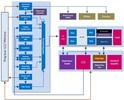Intel HD Graphics 5500 vs Intel HD Graphics 3000 vs Intel HD Graphics 2500
Intel HD Graphics 5500 ► remove from comparison
The Intel HD Graphics 5500 (GT2) is an integrated Broadwell graphics card revealed in Q1 2015. It can be found in several ULV SoCs (15 W TDP) such as the Core i5-5200U or i7-5600U . While Core i5 and Core i7 chips feature 24 EUs, the Core i3 version offers just 23 EUs. Depending on the specific CPU, the maximum GPU frequency varies between 850 and 950 MHz.
Architecture and Features
Broadwell features a GPU based on the Intel Gen8 architecture, which has been optimized in various aspects compared to the previous Gen7.5 (Haswell). Inter alia, the shader arrays called "subslice" have been reorganized and now offer 8 Execution Units (EUs) each. Three subslices form a "slice" for a total of 24 EUs. Combined with other improvements such as larger L1 caches and an optimized frontend, the integrated GPU has become faster and more efficient than its predecessor.
The HD Graphics 5500 represents the mid-range version of the Broadwell GPU family and consists of one slice with 24 EUs. Beyond that, there is also a low-end variant (GT1, 12 EUs) as well as higher-end models (GT3/GT3e + eDRAM, 48 EUs).
All Broadwell GPUs support OpenCL 2.0 and DirectX 12 (FL 11_1) . The video engine can now decode H.265 using both fixed function hardware as well as available GPU shaders. Up to three displays can be connected via DP 1.2/eDP 1.3 (max. 3840 x 2160 @ 60 Hz) or HDMI 1.4a (max. 3840 x 2160 @ 24 Hz). HDMI 2.0, however, is not supported.
Performance
Depending on the specific CPU, the maximum GPU frequency varies between 850 and 950 MHz. Due to the low TDP, however, the average clock in 3D applications will be somewhat lower.
Equipped with fast dual-channel memory, the HD Graphics 5500 outperforms the HD Graphics 4400 (Haswell, 20 EUs) by 20 - 25 percent and also beats the HD Graphics 5000 (Haswell, 40 EUs). However, even a low-end dedicated GeForce 820M ist about 10 - 30 percent faster than the HD 5500. Games as of 2014/2015 will usually run fluently only at (very) low settings.
Power Consumption
Utilizing a new 14 nm process, the Broadwell ULV chips are specified at just 15 W TDP and therefore suited for thin ultrabooks. The TDP is flexible and can be further reduced (7.5 or 10 W), which has a significant impact on performance.
Intel HD Graphics 3000 ► remove from comparison
The Intel HD Graphics 3000 (or Intel Graphics Media Accelerator HD 3000, GMA HD 3000, Intel HD Graphics 200) is an integrated graphics card in the Sandy Bridge codenamed processors. The HD Graphics 3000 has no dedicated memory but shares the Level 3 / LLC Cache with the CPU cores and also part of the main memory. Due to TurboBoost, the GPU can be overclocked depending on the current CPU load and power consumption. The base speed and the turbo boost speed of the HD Graphics 3000 depend on the processor:
ULV processors Core ix-2xx7 (base 350MHz, Turbo 900-1000MHz) LV processors Core ix-2xx5 (base 500MHz, Turbo 1000MHz) Mainstream and high-end Dual und Quad-Core Core ix-2xx0 (base 650MHz, Turbo 1100-1300MHz) Desktop K processors (base 850, Turbo 1100-1350MHz) The HD 3000 offers 12 Execution Units (EUs) like the old Intel GMA HD but due to architectural changes each EU is now faster. The slower HD Graphics 2000 uses only 6 Execution Units. The EUs can be accessed using DirectX 10.1, OpenGL 3.0 and DirectCompute 4.1. OpenCL is not supported (the media SDK only uses the CPU).
Our performance tests with the high clocked mainstream version of the HD Graphics 3000 in quad-core processors showed a performance level on par with older entry level generations from NVIDIA (e.g. GeForce 310M ) and AMD (HD 5450 ). In comparison with AMD's APU models, the HD 3000 can only compete against the C-and E-series, but not the faster Llano and Trinity models. The quality of the Intel drivers has been improved over the years, so most games are flawlessly playable (if the minimum requirements are fullfilled).
We could measure smooth frame rates in games like Dead Space 3, World of Tanks, Fifa 13, Torchlight 2, Counter-Strike: GO reach, Diablo 3, and many older games, though usually only in minimal detail settings. For accurate performance analysis and gaming benchmarks, read our article "Intel HD Graphics 3000" or scroll down in this article.
Altought 2x Antialiasing (AA) is supported, the chip is as fast as when rendering 4x AA. In the Unigine Valley benchmark a i7-2637M for example reached the same score with 2x AA and 4x AA.
In addition to the GPU, the chip also houses some dedicated units for decoding and encoding HD videos . On the IDF Intel demonstrated the encoding of a 3 minute long 1080p video to an iPhone compatible format in 640x360 in only 14s. Another novelty of the Sandy Bridge GPU is the embedded DisplayPort eDP to connect internal Displays.
Due to the integration in the 32nm built CPU, the power consumption of the GPU should be quite low.
Intel HD Graphics 2500 ► remove from comparison
The Intel HD Graphics 2500 (or Ivy Bridge GT1) is an integrated graphics card in the Ivy Bridge codenamed desktop processors. It is the successor the the Intel HD Graphics 2000 in the Sandy Bridge CPUs and performs between the old HD 2000 and 3000 GPU (see benchmarks below). Usually it is used in the cheaper desktop Ivy bridge CPUs. The mobile version is simply called Intel HD Graphics and integrated in the Pentium and Celeron line.
Compared to the faster HD Graphics 4000 , the 2500 one features less Execution Units (6 versus 16) and only one texture sampler. Therefore, the performance is clearly worse and only suited for low demanding gaming. Intel states a 10 to 15% higher performance compared to the old Sandy Bridge based HD Graphics 2000. Therefore, only older casual games with low requirements are playable with the HD 2500.
A speciality of the Ivy Bridge GPUs is that 4x MSAA is supported in hardware now. However, 2x is only supported through software. The algorithm to support 2x is going through the 4x pipeline with a software algorithm, so performance is similar to 4x MSAA.
The integrated video decoder called Multi Format Codec Engine (MFX) was also improved and should allow even simultaneus 4K video decoding. DXVAChecker lists MPEG2, VC1, WMV9, and H264 as supported codecs. QuickSync for fast transcoding of videos was also optimized for higher performance and better image quality.
Another new feature is the support for up to 3 independent displays as AMD offers with theirs Eyefinity support (up to 6 displays).
Due to the 22nm 3D Tri-Gate production process, the power consumption is relatively low (the development was focused on performance per Watt).
Intel HD Graphics 5500 Intel HD Graphics 3000 Intel HD Graphics 2500 HD Graphics Series Codename Broadwell GT2 Sandy Bridge Ivy Bridge GT1 Architecture Gen. 8 Broadwell Gen. 6 Sandy Bridge Gen. 7 Ivy Bridge Pipelines 24 - unified 12 - unified 6 - unified Core Speed 300 - 950 (Boost) MHz 350 - 1350 (Boost) MHz 650 - 1150 (Boost) MHz Memory Bus Width 64/128 Bit 64/128 Bit 64/128 Bit Shared Memory yes yes yes API DirectX 12 (FL 11_1), OpenGL 4.3 DirectX 10.1, Shader 4.1, OpenGL 3.0 DirectX 11.0, Shader 5.0 Transistors 1.3 Billion technology 14 nm 32 nm 22 nm Features Quick Sync Date of Announcement 05.01.2015 01.02.2011 01.04.2012 Notebook Size large
CPU in HD Graphics 5500 GPU Base Speed GPU Boost / Turbo Intel Core i7-5600U 2 x 2600 MHz, 15 W 300 MHz 950 MHz Intel Core i7-5500U 2 x 2400 MHz, 15 W 300 MHz 950 MHz Intel Core i5-5300U 2 x 2300 MHz, 15 W 300 MHz 900 MHz » show 5 more Intel Core i5-5200U 2 x 2200 MHz, 15 W 300 MHz 900 MHz Intel Core i3-5020U 2 x 2200 MHz, 15 W 300 MHz 900 MHz Intel Core i3-5010U 2 x 2100 MHz, 15 W 300 MHz 900 MHz Intel Core i3-5015U 2 x 2100 MHz, 15 W 300 MHz 850 MHz Intel Core i3-5005U 2 x 2000 MHz, 15 W 300 MHz 850 MHz min. - max. 300 MHz 850 - 950 MHz
CPU in HD Graphics 3000 GPU Base Speed GPU Boost / Turbo Intel Core i7-2700K 4 x 3500 MHz, 95 W 850 MHz 1350 MHz Intel Core i7-2600K 4 x 3400 MHz, 95 W 850 MHz 1350 MHz Intel Core i7-2960XM 4 x 2700 MHz, 55 W 650 MHz 1300 MHz » show 41 more Intel Core i7-2860QM 4 x 2500 MHz, 45 W 650 MHz 1300 MHz Intel Core i7-2920XM 4 x 2500 MHz, 55 W 650 MHz 1300 MHz Intel Core i5-2500K 4 x 3300 MHz, 95 W 850 MHz 1100 MHz Intel Core i7-2760QM 4 x 2400 MHz, 45 W 650 MHz 1300 MHz Intel Core i7-2820QM 4 x 2300 MHz, 45 W 650 MHz 1300 MHz Intel Core i7-2720QM 4 x 2200 MHz, 45 W 650 MHz 1300 MHz Intel Core i7-2675QM 4 x 2200 MHz, 45 W 650 MHz 1200 MHz Intel Core i7-2670QM 4 x 2200 MHz, 45 W 650 MHz 1100 MHz Intel Core i7-2635QM 4 x 2000 MHz, 45 W 650 MHz 1200 MHz Intel Core i7-2630QM 4 x 2000 MHz, 45 W 650 MHz 1100 MHz Intel Core i7-2640M 2 x 2800 MHz, 35 W 650 MHz 1300 MHz Intel Core i7-2620M 2 x 2700 MHz, 35 W 650 MHz 1300 MHz Intel Core i5-2540M 2 x 2600 MHz, 35 W 650 MHz 1300 MHz Intel Core i5-2520M 2 x 2500 MHz, 35 W 650 MHz 1300 MHz Intel Core i5-2450M 2 x 2500 MHz, 35 W 650 MHz 1300 MHz Intel Core i5-2435M 2 x 2400 MHz, 35 W 650 MHz 1300 MHz Intel Core i5-2430M 2 x 2400 MHz, 35 W 650 MHz 1200 MHz Intel Core i5-2415M 2 x 2300 MHz, 35 W 650 MHz 1300 MHz Intel Core i5-2410M 2 x 2300 MHz, 35 W 650 MHz 1200 MHz Intel Core i7-2649M 2 x 2300 MHz, 25 W 500 MHz 1100 MHz Intel Core i3-2370M 2 x 2400 MHz, 35 W 650 MHz 1150 MHz Intel Core i3-2350M 2 x 2300 MHz, 35 W 650 MHz 1150 MHz Intel Core i3-2348M 2 x 2300 MHz, 35 W 650 MHz 1150 MHz Intel Core i7-2629M 2 x 2100 MHz, 25 W 500 MHz 1100 MHz Intel Core i7-2677M 2 x 1800 MHz, 17 W 350 MHz 1200 MHz Intel Core i3-2330M 2 x 2200 MHz, 35 W 650 MHz 1100 MHz Intel Core i3-2328M 2 x 2200 MHz, 35 W 650 MHz 1100 MHz Intel Core i7-2637M 2 x 1700 MHz, 17 W 350 MHz 1200 MHz Intel Core i7-2657M 2 x 1600 MHz, 17 W 350 MHz 1000 MHz Intel Core i3-2312M 2 x 2100 MHz, 35 W 350 MHz 1100 MHz Intel Core i3-2310M 2 x 2100 MHz, 35 W 650 MHz 1100 MHz Intel Core i3-2308M 2 x 2100 MHz, 35 W 650 MHz 1100 MHz Intel Core i5-2557M 2 x 1700 MHz, 17 W 350 MHz 1200 MHz Intel Core i7-2617M 2 x 1500 MHz, 17 W 350 MHz 950 MHz Intel Core i5-2467M 2 x 1600 MHz, 17 W 350 MHz 1150 MHz Intel Core i5-2537M 2 x 1400 MHz, 17 W 350 MHz 900 MHz Intel Core i3-2377M 2 x 1500 MHz, 17 W 350 MHz 1000 MHz Intel Core i3-2375M 2 x 1500 MHz, 17 W 350 MHz 1000 MHz Intel Core i3-2367M 2 x 1400 MHz, 17 W 350 MHz 1000 MHz Intel Core i3-2365M 2 x 1400 MHz, 17 W 350 MHz 1000 MHz Intel Core i3-2357M 2 x 1300 MHz, 17 W 350 MHz 950 MHz min. - max. 300 - 850 MHz 850 - 1350 MHz
CPU in HD Graphics 2500 GPU Base Speed GPU Boost / Turbo Intel Core i5-3550 4 x 3300 MHz, 77 W 650 MHz 1150 MHz Intel Core i5-3470 4 x 3200 MHz, 77 W 650 MHz 1100 MHz Intel Core i3-3220 2 x 3300 MHz, 55 W 650 MHz 1050 MHz min. - max. 300 - 850 MHz 850 - 1350 MHz
Benchmarks Performance Rating - 3DMark 11 + Fire Strike + Time Spy - HD Graphics 5500
0.3 pt (1%)
...
...
max:
Performance Rating - 3DMark 11 + Fire Strike + Time Spy - HD Graphics 2500
0.1 pt (0%)
...
...
max:
3DMark - 3DMark Time Spy Score
289 Points (1%)
3DMark - 3DMark Time Spy Graphics
255 Points (1%)
3DMark - 3DMark Ice Storm Unlimited Graphics
min: 43391 avg: 58343 median: 58776 (7%) max: 68877 Points
3DMark - 3DMark Ice Storm Extreme Graphics
min: 27084 avg: 33172 median: 31022.5 (4%) max: 40670 Points
3DMark - 3DMark Cloud Gate Score
min: 3351 avg: 4777 median: 4790.5 (5%) max: 6106 Points
min: 2277 avg: 2642 median: 2656.5 (3%) max: 2979 Points
min: 1906 avg: 2659 median: 2817 (3%) max: 3095 Points
3DMark - 3DMark Cloud Gate Graphics
min: 4571 avg: 5864 median: 5544 (1%) max: 7789 Points
min: 2356 avg: 2593 median: 2502.5 (1%) max: 3011 Points
min: 2301 avg: 2584 median: 2604.5 (1%) max: 2825 Points
3DMark - 3DMark Fire Strike Standard Score
min: 500 avg: 648 median: 634.5 (1%) max: 868 Points
min: 257 avg: 293.3 median: 294.5 (1%) max: 327 Points
3DMark - 3DMark Fire Strike Standard Graphics
min: 535 avg: 694 median: 663 (1%) max: 927 Points
min: 289 avg: 319.5 median: 318 (0%) max: 353 Points
3DMark - 3DMark Ice Storm Graphics
min: 33288 avg: 50089 median: 48637 (6%) max: 70409 Points
min: 25494 avg: 29036 median: 27124 (3%) max: 36403 Points
min: 21978 avg: 23693 median: 24058 (3%) max: 24676 Points
3DMark 11 - 3DM11 Performance Score
min: 758 avg: 1088 median: 1079.5 (1%) max: 1434 Points
min: 374 avg: 419 median: 430 (1%) max: 449 Points
3DMark 11 - 3DM11 Performance GPU
min: 667 avg: 979 median: 979 (1%) max: 1265 Points
min: 321 avg: 349 median: 350.5 (0%) max: 374 Points
3DMark Vantage + Intel HD Graphics 5500 3DMark Vantage - 3DM Vant. Perf. total
min: 3574 avg: 4501 median: 4798 (1%) max: 5124 Points
3DM Vant. Perf. total + Intel HD Graphics 3000
min: 1135 avg: 1560 median: 1568 (0%) max: 2164 Points
3DM Vant. Perf. total + Intel HD Graphics 2500
min: 1375 avg: 1849 median: 1930.5 (1%) max: 2068 Points
3DM Vant. Perf. GPU no PhysX + Intel HD Graphics 5500 3DMark Vantage - 3DM Vant. Perf. GPU no PhysX
min: 3057 avg: 3804 median: 3987 (2%) max: 4351 Points
3DM Vant. Perf. GPU no PhysX + Intel HD Graphics 3000
min: 927 avg: 1331 median: 1240 (1%) max: 8858 Points
3DM Vant. Perf. GPU no PhysX + Intel HD Graphics 2500
min: 1115 avg: 1369 median: 1400.5 (1%) max: 1561 Points
3DMark 2001SE - 3DMark 2001 - Standard
min: 7796 avg: 12752 median: 11654 (12%) max: 19742 Points
20814 Points (22%)
Model CPU GPU RAM Value Intel Core i5-3470, Intel DZ77GA-70K Desktop, DDR3-1600 3470 HD Graphics 2500 1100 MHz8 GB 20814
3DMark 03 - 3DMark 03 - Standard
min: 5162 avg: 8577 median: 7751 (4%) max: 12358 Points
10138 Points (5%)
Model CPU GPU RAM Value Intel Core i5-3470, Intel DZ77GA-70K Desktop, DDR3-1600 3470 HD Graphics 2500 1100 MHz8 GB 10138
3DMark 05 - 3DMark 05 - Standard
min: 3498 avg: 6355 median: 5968 (7%) max: 9344 Points
min: 6341 avg: 6627 median: 6627 (7%) max: 6913 Points
Model CPU GPU RAM Value Intel Core i3-3220, Intel DZ77GA-70K Desktop, DDR3-1600 3220 HD Graphics 2500 1050 MHz8 GB 6341 Intel Core i5-3470, Intel DZ77GA-70K Desktop, DDR3-1600 3470 HD Graphics 2500 1100 MHz8 GB 6913
3DMark 06 3DMark 06 - Standard 1280x1024 + Intel HD Graphics 5500
min: 5458 avg: 6875 median: 6998 (9%) max: 7950 Points
3DMark 06 - Standard 1280x1024 + Intel HD Graphics 3000
min: 1392 avg: 3451 median: 3286.5 (4%) max: 5853 Points
3DMark 06 - Standard 1280x1024 + Intel HD Graphics 2500
min: 3300 avg: 3933 median: 3816 (5%) max: 4442 Points
3DMark 06 - Standard 1280x800 + Intel HD Graphics 5500
7725 Points (10%)
3DMark 06 - Standard 1280x800 + Intel HD Graphics 3000
min: 2550 avg: 3176 median: 3224 (4%) max: 3753 Points
3DMark 06 - Score Unknown Settings + Intel HD Graphics 3000
min: 3508 avg: 3847 median: 3617 (5%) max: 5041 Points
3DMark 06 - Standard 1280x768 + Intel HD Graphics 3000
min: 2788 avg: 3293 median: 3308 (4%) max: 3942 Points
Unigine Heaven 3.0 - Unigine Heaven 3.0 DX 11
9.3 fps (3%)
Unigine Heaven 3.0 - Unigine Heaven 3.0 OpenGL
9.8 fps (4%)
Unigine Heaven 2.1 - Heaven 2.1 high
min: 12.4 avg: 15.5 median: 15.7 (3%) max: 17.9 fps
min: 4 avg: 7.7 median: 7.8 (1%) max: 9.3 fps
SPECviewperf 11 + Intel HD Graphics 5500 SPECviewperf 11 - specvp11 snx-01
min: 1.89 avg: 2.1 median: 2 (1%) max: 2.29 fps
specvp11 snx-01 + Intel HD Graphics 3000 min: 0.18 avg: 0.3 median: 0.2 (0%) max: 0.75 fps
specvp11 snx-01 + Intel HD Graphics 2500
1.6 fps (1%)
Model CPU GPU RAM Value Intel Core i5-3470, Intel DZ77GA-70K Desktop, DDR3-1600 3470 HD Graphics 2500 1100 MHz8 GB 1.61
specvp11 tcvis-02 + Intel HD Graphics 5500 SPECviewperf 11 - specvp11 tcvis-02
min: 2.42 avg: 2.6 median: 2.6 (1%) max: 2.9 fps
specvp11 tcvis-02 + Intel HD Graphics 3000 min: 0.12 avg: 0.3 median: 0.2 (0%) max: 0.86 fps
specvp11 tcvis-02 + Intel HD Graphics 2500
2.7 fps (2%)
Model CPU GPU RAM Value Intel Core i5-3470, Intel DZ77GA-70K Desktop, DDR3-1600 3470 HD Graphics 2500 1100 MHz8 GB 2.66
specvp11 sw-02 + Intel HD Graphics 5500 SPECviewperf 11 - specvp11 sw-02
min: 11.6 avg: 13 median: 12.5 (9%) max: 14.7 fps
specvp11 sw-02 + Intel HD Graphics 3000
min: 2.55 avg: 3.6 median: 3.6 (3%) max: 4.61 fps
specvp11 sw-02 + Intel HD Graphics 2500
6.8 fps (5%)
Model CPU GPU RAM Value Intel Core i5-3470, Intel DZ77GA-70K Desktop, DDR3-1600 3470 HD Graphics 2500 1100 MHz8 GB 6.76
specvp11 proe-05 + Intel HD Graphics 5500 SPECviewperf 11 - specvp11 proe-05
min: 2.14 avg: 2.3 median: 2.3 (3%) max: 2.53 fps
specvp11 proe-05 + Intel HD Graphics 3000
min: 0.26 avg: 0.5 median: 0.5 (1%) max: 0.65 fps
specvp11 proe-05 + Intel HD Graphics 2500
1.9 fps (2%)
Model CPU GPU RAM Value Intel Core i5-3470, Intel DZ77GA-70K Desktop, DDR3-1600 3470 HD Graphics 2500 1100 MHz8 GB 1.86
specvp11 maya-03 + Intel HD Graphics 5500 SPECviewperf 11 - specvp11 maya-03
min: 8.07 avg: 13.6 median: 14.7 (11%) max: 18.15 fps
specvp11 maya-03 + Intel HD Graphics 3000
min: 1.07 avg: 4.6 median: 5 (4%) max: 7.63 fps
specvp11 maya-03 + Intel HD Graphics 2500
12.9 fps (10%)
Model CPU GPU RAM Value Intel Core i5-3470, Intel DZ77GA-70K Desktop, DDR3-1600 3470 HD Graphics 2500 1100 MHz8 GB 12.91
specvp11 lightwave-01 + Intel HD Graphics 5500 SPECviewperf 11 - specvp11 lightwave-01
min: 14.7 avg: 18.4 median: 18.6 (20%) max: 21.44 fps
specvp11 lightwave-01 + Intel HD Graphics 3000
min: 3.63 avg: 5.5 median: 5.5 (6%) max: 7.35 fps
specvp11 lightwave-01 + Intel HD Graphics 2500
15.6 fps (17%)
Model CPU GPU RAM Value Intel Core i5-3470, Intel DZ77GA-70K Desktop, DDR3-1600 3470 HD Graphics 2500 1100 MHz8 GB 15.59
specvp11 ensight-04 + Intel HD Graphics 5500 SPECviewperf 11 - specvp11 ensight-04
min: 1.67 avg: 2.5 median: 2.6 (1%) max: 2.88 fps
specvp11 ensight-04 + Intel HD Graphics 3000
min: 0.1 avg: 0.4 median: 0.1 (0%) max: 1.29 fps
specvp11 ensight-04 + Intel HD Graphics 2500
2.4 fps (1%)
Model CPU GPU RAM Value Intel Core i5-3470, Intel DZ77GA-70K Desktop, DDR3-1600 3470 HD Graphics 2500 1100 MHz8 GB 2.4
specvp11 catia-03 + Intel HD Graphics 2500 SPECviewperf 11 - specvp11 catia-03
0 fps (0%)
Model CPU GPU RAM Value Intel Core i5-3470, Intel DZ77GA-70K Desktop, DDR3-1600 3470 HD Graphics 2500 1100 MHz8 GB 0
SPECviewperf 12 + Intel HD Graphics 5500 SPECviewperf 12 - specvp12 sw-03
min: 2.12 avg: 9.9 median: 12.3 (3%) max: 15.6 fps
specvp12 snx-02 + Intel HD Graphics 5500 SPECviewperf 12 - specvp12 snx-02
min: 1.37 avg: 2.3 median: 2.4 (0%) max: 2.7 fps
specvp12 showcase-01 + Intel HD Graphics 5500 SPECviewperf 12 - specvp12 showcase-01
min: 2.63 avg: 7 median: 4.2 (1%) max: 14.14 fps
specvp12 mediacal-01 + Intel HD Graphics 5500 SPECviewperf 12 - specvp12 mediacal-01
min: 0.95 avg: 1.4 median: 1 (0%) max: 2.36 fps
specvp12 maya-04 + Intel HD Graphics 5500 SPECviewperf 12 - specvp12 maya-04
min: 2.49 avg: 6.3 median: 2.6 (1%) max: 12.31 fps
specvp12 energy-01 + Intel HD Graphics 5500 SPECviewperf 12 - specvp12 energy-01
min: 0.06 avg: 6.9 median: 0.1 (0%) max: 17.35 fps
specvp12 creo-01 + Intel HD Graphics 5500 SPECviewperf 12 - specvp12 creo-01
min: 2.49 avg: 5.7 median: 6.5 (3%) max: 8.99 fps
specvp12 catia-04 + Intel HD Graphics 5500 SPECviewperf 12 - specvp12 catia-04
min: 6.86 avg: 7.7 median: 7.1 (1%) max: 9.69 fps
Windows 7 Experience Index - Win7 Gaming graphics
min: 5.5 avg: 6.1 median: 6.1 (77%) max: 6.4 Points
Windows 7 Experience Index - Win7 Graphics
min: 4.1 avg: 5.1 median: 4.7 (59%) max: 6.4 Points
Cinebench R10 Cinebench R10 Shading (32bit) + Intel HD Graphics 5500 Cinebench R10 - Cinebench R10 Shading (32bit)
min: 3045 avg: 5408 median: 5270.5 (4%) max: 8571 Points
Cinebench R10 Shading (32bit) + Intel HD Graphics 3000
min: 1712 avg: 4274 median: 4414 (3%) max: 7038 Points
Cinebench R10 Shading (32bit) + Intel HD Graphics 2500
min: 3409 avg: 5543 median: 6037 (4%) max: 6687 Points
Cinebench R11.5 Cinebench R11.5 OpenGL 64 Bit + Intel HD Graphics 5500 Cinebench R11.5 - Cinebench R11.5 OpenGL 64 Bit
min: 13.54 avg: 21.2 median: 20.3 (7%) max: 35.03 fps
Cinebench R11.5 OpenGL 64 Bit + Intel HD Graphics 3000
min: 4.75 avg: 8.7 median: 8.4 (3%) max: 13.02 fps
Cinebench R11.5 OpenGL 64 Bit + Intel HD Graphics 2500
min: 9.09 avg: 10.6 median: 10.8 (4%) max: 11.98 fps
Cinebench R15 + Intel HD Graphics 5500 Cinebench R15 - Cinebench R15 OpenGL 64 Bit
min: 16.42 avg: 26.3 median: 25.4 (1%) max: 35.04 fps
Cinebench R15 OpenGL 64 Bit + Intel HD Graphics 3000 0 fps (0%)
Cinebench R15 OpenGL Ref. Match 64 Bit + Intel HD Graphics 5500 Cinebench R15 - Cinebench R15 OpenGL Ref. Match 64 Bit
min: 98 avg: 98 median: 98 (98%) max: 99.6 %
Cinebench R15 OpenGL Ref. Match 64 Bit + Intel HD Graphics 3000
min: 32.2 avg: 32.6 median: 32.6 (33%) max: 32.9 %
GFXBench 3.0 - GFXBench 3.0 Manhattan Offscreen
min: 26.9 avg: 32.4 median: 30.6 (2%) max: 44.6 fps
GFXBench (DX / GLBenchmark) 2.7 + Intel HD Graphics 5500 GFXBench (DX / GLBenchmark) 2.7 - GFXBench T-Rex HD Offscreen C24Z16
min: 60.9 avg: 70.9 median: 70.9 (1%) max: 87.6 fps
Basemark GPU 1.2 - Basemark GPU 1.2 Vulkan Official Medium Offscreen 1080
105 fps (1%)
LuxMark v2.0 64Bit - LuxMark v2.0 Room GPU
min: 128 avg: 166.7 median: 149 (1%) max: 306 Samples/s
min: 30 avg: 31 median: 31 (0%) max: 32 Samples/s
LuxMark v2.0 64Bit - LuxMark v2.0 Sala GPU
min: 134 avg: 311.5 median: 328 (1%) max: 409 Samples/s
min: 47 avg: 50 median: 50 (0%) max: 53 Samples/s
ComputeMark v2.1 - ComputeMark v2.1 Result
min: 643 avg: 689 median: 695 (1%) max: 734 Points
min: 282 avg: 287.3 median: 286 (0%) max: 294 Points
Power Consumption - Furmark Stress Test Power Consumption - external Monitor *
min: 27.2 avg: 27.8 median: 27.8 (4%) max: 28.3 Watt
Power Consumption - The Witcher 3 Power Consumption - external Monitor *
26.5 Watt (4%)
Emissions Witcher 3 Fan Noise + Intel HD Graphics 5500 Emissions - Witcher 3 Fan Noise
37.5 dB(A) (60%)
Clock Speed - GPU Clock Witcher 3 ultra
898 MHz (35%)
Clock Speed - GPU Clock Speed Furmark
749 MHz (30%)
Average Benchmarks Intel HD Graphics 5500 → 100% n=15 Average Benchmarks Intel HD Graphics 3000 → 35% n=15 Average Benchmarks Intel HD Graphics 2500 → 69% n=15
- Range of benchmark values for this graphics card
- Average benchmark values for this graphics card
* Smaller numbers mean a higher performance
1 This benchmark is not used for the average calculation
Game Benchmarks The following benchmarks stem from our benchmarks of review laptops. The performance depends on the used graphics memory, clock rate, processor, system settings, drivers, and operating systems. So the results don't have to be representative for all laptops with this GPU. For detailed information on the benchmark results, click on the fps number.
100%
HD Graphics 5500:
9.4 [X] Asus F555LF-XO029H Intel Core i5-5200U 2.2GHz
HD Graphics 5500
fps
100%
HD Graphics 5500:
12.8 [X] Asus F555LF-XO029H Intel Core i5-5200U 2.2GHz
HD Graphics 5500
fps
100%
HD Graphics 5500:
29.3 fps
100%
HD Graphics 5500:
6.1 [X] Asus F555LF-XO029H Intel Core i5-5200U 2.2GHz
HD Graphics 5500
fps
100%
HD Graphics 5500:
10.1 [X] Asus F555LF-XO029H Intel Core i5-5200U 2.2GHz
HD Graphics 5500
fps
100%
HD Graphics 5500:
41.4 [X] Asus F555LF-XO029H Intel Core i5-5200U 2.2GHz
HD Graphics 5500
fps
100%
HD Graphics 5500:
13.9 [X] Asus F555LF-XO029H Intel Core i5-5200U 2.2GHz
HD Graphics 5500
fps
100%
HD Graphics 5500:
12.1 [X] Asus F555LF-XO029H Intel Core i5-5200U 2.2GHz
HD Graphics 5500
fps
100%
HD Graphics 5500:
21.4 21.5 [X] Asus F555LF-XO029H Intel Core i5-5200U 2.2GHz
HD Graphics 5500
~ 21 fps
100%
HD Graphics 5500:
15.5 [X] Asus F555LF-XO029H Intel Core i5-5200U 2.2GHz
HD Graphics 5500
min:
13 fps, max:
17 fps
18.3 ~ 17 fps
100%
HD Graphics 5500:
14.9 [X] Asus F555LF-XO029H Intel Core i5-5200U 2.2GHz
HD Graphics 5500
fps
100%
HD Graphics 5500:
15 [X] Asus F555LF-XO029H Intel Core i5-5200U 2.2GHz
HD Graphics 5500
fps
100%
HD Graphics 5500:
29.5 [X] Asus F555LF-XO029H Intel Core i5-5200U 2.2GHz
HD Graphics 5500
fps
100%
HD Graphics 5500:
6 [X] Asus F555LF-XO029H Intel Core i5-5200U 2.2GHz
HD Graphics 5500
fps
100%
HD Graphics 5500:
9 [X] Asus F555LF-XO029H Intel Core i5-5200U 2.2GHz
HD Graphics 5500
fps
100%
HD Graphics 5500:
5 [X] Asus F555LF-XO029H Intel Core i5-5200U 2.2GHz
HD Graphics 5500
fps
100%
HD Graphics 5500:
19.8 [X] Asus F555LF-XO029H Intel Core i5-5200U 2.2GHz
HD Graphics 5500
fps
100%
HD Graphics 5500:
11.1 [X] Asus F555LF-XO029H Intel Core i5-5200U 2.2GHz
HD Graphics 5500
fps
100%
HD Graphics 5500:
20 [X] Asus F555LF-XO029H Intel Core i5-5200U 2.2GHz
HD Graphics 5500
fps
100%
HD Graphics 5500:
17.1 [X] Asus F555LF-XO029H Intel Core i5-5200U 2.2GHz
HD Graphics 5500
fps
100%
HD Graphics 5500:
44.6 [X] Asus F555LF-XO029H Intel Core i5-5200U 2.2GHz
HD Graphics 5500
fps
100%
HD Graphics 5500:
12.2 [X] Asus F555LF-XO029H Intel Core i5-5200U 2.2GHz
HD Graphics 5500
fps
100%
HD Graphics 5500:
9.5 [X] Asus F555LF-XO029H Intel Core i5-5200U 2.2GHz
HD Graphics 5500
fps
100%
HD Graphics 5500:
13.4 [X] Asus F555LF-XO029H Intel Core i5-5200U 2.2GHz
HD Graphics 5500
fps
HD Graphics 5500:
0 (!) [X] Asus F555LF-XO029H Intel Core i5-5200U 2.2GHz
HD Graphics 5500
fps
100%
HD Graphics 5500:
7 [X] Asus F555LF-XO029H Intel Core i5-5200U 2.2GHz
HD Graphics 5500
fps
100%
HD Graphics 5500:
42.9 (!) [X] Asus F555LF-XO029H Intel Core i5-5200U 2.2GHz
HD Graphics 5500
fps
100%
HD Graphics 5500:
10 [X] Asus F555LF-XO029H Intel Core i5-5200U 2.2GHz
HD Graphics 5500
fps
HD Graphics 5500:
0 (!) [X] HP 250 G5 i3-5005U MX500 Intel Core i3-5005U 2GHz
HD Graphics 5500
fps
100%
HD Graphics 5500:
19 [X] Asus F555LF-XO029H Intel Core i5-5200U 2.2GHz
HD Graphics 5500
fps
100%
HD Graphics 5500:
8.9 [X] Asus F555LF-XO029H Intel Core i5-5200U 2.2GHz
HD Graphics 5500
fps
100%
HD Graphics 5500:
14.3 [X] Asus F555LF-XO029H Intel Core i5-5200U 2.2GHz
HD Graphics 5500
fps
100%
HD Graphics 5500:
11 [X] Asus F555LF-XO029H Intel Core i5-5200U 2.2GHz
HD Graphics 5500
fps
100%
HD Graphics 5500:
131.8 [X] Asus F555LF-XO029H Intel Core i5-5200U 2.2GHz
HD Graphics 5500
fps
100%
HD Graphics 5500:
14.8 [X] Asus F555LF-XO029H Intel Core i5-5200U 2.2GHz
HD Graphics 5500
fps
100%
HD Graphics 5500:
14 [X] HP 250 G5 i3-5005U MX500 Intel Core i3-5005U 2GHz
HD Graphics 5500
17.1 18 [X] Asus F555LF-XO029H Intel Core i5-5200U 2.2GHz
HD Graphics 5500
~ 16 fps
100%
HD Graphics 5500:
9.3 [X] HP 250 G5 i3-5005U MX500 Intel Core i3-5005U 2GHz
HD Graphics 5500
11.8 ~ 11 fps
100%
HD Graphics 5500:
8.2 [X] HP 250 G5 i3-5005U MX500 Intel Core i3-5005U 2GHz
HD Graphics 5500
10.5 ~ 9 fps
100%
HD Graphics 5500:
12.1 [X] Asus F555LF-XO029H Intel Core i5-5200U 2.2GHz
HD Graphics 5500
fps
100%
HD Graphics 5500:
6.9 [X] HP 250 G5 i3-5005U MX500 1.3
Intel Core i3-5005U 2GHz
HD Graphics 5500
16.1 [X] Asus F555LF-XO029H Intel Core i5-5200U 2.2GHz
HD Graphics 5500
~ 12 fps
100%
HD Graphics 5500:
72.6 [X] Asus F555LF-XO029H Intel Core i5-5200U 2.2GHz
HD Graphics 5500
fps
100%
HD Graphics 5500:
15.5 [X] Asus F555LF-XO029H Intel Core i5-5200U 2.2GHz
HD Graphics 5500
fps
100%
HD Graphics 5500:
23.6 [X] Asus F555LF-XO029H Intel Core i5-5200U 2.2GHz
HD Graphics 5500
fps
100%
HD Graphics 5500:
6 [X] Asus F555LF-XO029H Intel Core i5-5200U 2.2GHz
HD Graphics 5500
fps
100%
HD Graphics 5500:
11.2 [X] Asus F555LF-XO029H Intel Core i5-5200U 2.2GHz
HD Graphics 5500
fps
100%
HD Graphics 5500:
9.8 [X] Asus F555LF-XO029H Intel Core i5-5200U 2.2GHz
HD Graphics 5500
fps
100%
HD Graphics 5500:
14 [X] Asus F555LF-XO029H Intel Core i5-5200U 2.2GHz
HD Graphics 5500
fps
100%
HD Graphics 5500:
56.1 [X] Asus F555LF-XO029H Intel Core i5-5200U 2.2GHz
HD Graphics 5500
fps
100%
HD Graphics 5500:
10.9 [X] Asus F555LF-XO029H Intel Core i5-5200U 2.2GHz
HD Graphics 5500
fps
100%
HD Graphics 5500:
23 [X] Asus F555LF-XO029H Intel Core i5-5200U 2.2GHz
HD Graphics 5500
fps
100%
HD Graphics 5500:
68 fps
71%
HD Graphics 3000:
48.4 [X] Acer Aspire M3-581TG Intel Core i7-2637M 1.7GHz
HD Graphics 3000
min:
40 fps
fps
100%
HD Graphics 5500:
63 fps
100%
HD Graphics 5500:
36.4 (!) [X] Intel NUC5i3RYK Intel Core i3-5010U 2.1GHz
HD Graphics 5500
min:
31 fps
fps
100%
HD Graphics 5500:
14 (!) [X] Intel NUC5i3RYK Intel Core i3-5010U 2.1GHz
HD Graphics 5500
min:
13 fps
fps
100%
HD Graphics 5500:
34.2 fps
100%
HD Graphics 5500:
63.7 fps
100%
HD Graphics 5500:
21.7 [X] Asus F555LF-XO029H Intel Core i5-5200U 2.2GHz
HD Graphics 5500
fps
100%
HD Graphics 5500:
11.2 [X] Asus F555LF-XO029H Intel Core i5-5200U 2.2GHz
HD Graphics 5500
fps
100%
HD Graphics 5500:
25 [X] Asus F555LF-XO029H Intel Core i5-5200U 2.2GHz
HD Graphics 5500
fps
100%
HD Graphics 5500:
30.8 [X] Asus F555LF-XO029H Intel Core i5-5200U 2.2GHz
HD Graphics 5500
fps
100%
HD Graphics 5500:
21.6 [X] Asus F555LF-XO029H Intel Core i5-5200U 2.2GHz
HD Graphics 5500
fps
100%
HD Graphics 5500:
60.7 fps
36%
HD Graphics 3000:
22.1 [X] Acer Aspire M3-581TG Intel Core i7-2637M 1.7GHz
HD Graphics 3000
min:
13 fps, max:
27 fps
fps
HD Graphics 3000:
13.2 [X] Acer Aspire M3-581TG Intel Core i7-2637M 1.7GHz
HD Graphics 3000
min:
6 fps, max:
17 fps
fps
100%
HD Graphics 5500:
20.7 [X] Asus F555LF-XO029H Intel Core i5-5200U 2.2GHz
HD Graphics 5500
fps
100%
HD Graphics 5500:
13.3 [X] Asus F555LF-XO029H Intel Core i5-5200U 2.2GHz
HD Graphics 5500
fps
100%
HD Graphics 5500:
21.5 fps
100%
HD Graphics 5500:
12.6 fps
100%
HD Graphics 5500:
31.6 fps
0%
HD Graphics 3000:
0 (!) [X] Acer Aspire M3-581TG Intel Core i7-2637M 1.7GHz
HD Graphics 3000
fps
100%
HD Graphics 5500:
0 (!) [X] Intel NUC5i3RYK Intel Core i3-5010U 2.1GHz
HD Graphics 5500
18.4 [X] Asus F555LF-XO029H Intel Core i5-5200U 2.2GHz
HD Graphics 5500
~ 9 fps
100%
HD Graphics 5500:
14.7 [X] Asus F555LF-XO029H Intel Core i5-5200U 2.2GHz
HD Graphics 5500
fps
100%
HD Graphics 5500:
11.4 fps
100%
HD Graphics 5500:
7.3 fps
100%
HD Graphics 5500:
24.6 27 ~ 26 fps
100%
HD Graphics 5500:
13.8 16.9 ~ 15 fps
100%
HD Graphics 5500:
9.9 fps
100%
HD Graphics 5500:
7.8 fps
100%
HD Graphics 5500:
16.3 fps
100%
HD Graphics 5500:
14.4 fps
100%
HD Graphics 5500:
16.4 [X] Intel NUC Kit NUC5i3RYH Intel Core i3-5010U 2.1GHz
HD Graphics 5500
min:
9 fps
fps
100%
HD Graphics 5500:
9.7 [X] Intel NUC Kit NUC5i3RYH Intel Core i3-5010U 2.1GHz
HD Graphics 5500
min:
6 fps
fps
HD Graphics 5500:
0 (!) [X] Intel NUC Kit NUC5i3RYH Intel Core i3-5010U 2.1GHz
HD Graphics 5500
fps
100%
HD Graphics 5500:
25.1 [X] Intel NUC Kit NUC5i3RYH Intel Core i3-5010U 2.1GHz
HD Graphics 5500
min:
22 fps
fps
100%
HD Graphics 5500:
15.1 [X] Intel NUC Kit NUC5i3RYH Intel Core i3-5010U 2.1GHz
HD Graphics 5500
min:
13 fps
fps
100%
HD Graphics 5500:
7.3 [X] Intel NUC Kit NUC5i3RYH Intel Core i3-5010U 2.1GHz
HD Graphics 5500
min:
5 fps
fps
100%
HD Graphics 5500:
8.3 [X] Intel NUC Kit NUC5i3RYH Intel Core i3-5010U 2.1GHz
HD Graphics 5500
min:
7 fps
fps
100%
HD Graphics 5500:
5 [X] Intel NUC Kit NUC5i3RYH Intel Core i3-5010U 2.1GHz
HD Graphics 5500
min:
1 fps
fps
100%
HD Graphics 5500:
2.8 [X] Intel NUC Kit NUC5i3RYH Intel Core i3-5010U 2.1GHz
HD Graphics 5500
min:
1 fps
fps
100%
HD Graphics 5500:
42.4 55.9 [X] Intel NUC Kit NUC5i3RYH Intel Core i3-5010U 2.1GHz
HD Graphics 5500
min:
50 fps
~ 49 fps
0%
HD Graphics 3000:
0 (!) [X] Acer Aspire M3-581TG Intel Core i7-2637M 1.7GHz
HD Graphics 3000
fps
100%
HD Graphics 5500:
33.8 35.7 [X] Intel NUC Kit NUC5i3RYH Intel Core i3-5010U 2.1GHz
HD Graphics 5500
min:
31 fps
~ 35 fps
100%
HD Graphics 5500:
17.2 18.1 [X] Intel NUC Kit NUC5i3RYH Intel Core i3-5010U 2.1GHz
HD Graphics 5500
min:
7 fps
~ 18 fps
100%
HD Graphics 5500:
48.6 49.6 [X] Intel NUC5i3RYK 0.5.0.0
Intel Core i3-5010U 2.1GHz
HD Graphics 5500
min:
28 fps, max:
66 fps
~ 49 fps
65%
HD Graphics 3000:
25.1 [X] Acer Aspire M3-581TG Intel Core i7-2637M 1.7GHz
HD Graphics 3000
38 [X] Compal Barebone Intel Core i7-2860QM 2.5GHz
HD Graphics 3000
min:
29 fps, max:
49 fps
~ 32 fps
100%
HD Graphics 5500:
35.6 37.3 ~ 36 fps
53%
HD Graphics 3000:
15.6 [X] Acer Aspire M3-581TG Intel Core i7-2637M 1.7GHz
HD Graphics 3000
min:
11 fps, max:
21 fps
21.7 [X] Compal Barebone Intel Core i7-2860QM 2.5GHz
HD Graphics 3000
min:
14 fps, max:
31 fps
~ 19 fps
100%
HD Graphics 5500:
17.9 fps
100%
HD Graphics 5500:
13 13.2 [X] Intel NUC5i3RYK 0.5.0.0
Intel Core i3-5010U 2.1GHz
HD Graphics 5500
min:
8 fps, max:
22 fps
~ 13 fps
100%
HD Graphics 5500:
27.8 33.5 37.1 [X] Intel NUC Kit NUC5i3RYH Intel Core i3-5010U 2.1GHz
HD Graphics 5500
min:
33 fps
~ 33 fps
100%
HD Graphics 5500:
18.9 21.1 25.4 [X] Intel NUC Kit NUC5i3RYH Intel Core i3-5010U 2.1GHz
HD Graphics 5500
min:
23 fps
~ 22 fps
100%
HD Graphics 5500:
8.7 9.4 [X] Intel NUC Kit NUC5i3RYH Intel Core i3-5010U 2.1GHz
HD Graphics 5500
min:
8 fps
~ 9 fps
100%
HD Graphics 5500:
16.2 18 [X] Intel NUC Kit NUC5i3RYH Intel Core i3-5010U 2.1GHz
HD Graphics 5500
min:
15 fps
~ 17 fps
100%
HD Graphics 5500:
7.9 8.3 [X] Intel NUC Kit NUC5i3RYH Intel Core i3-5010U 2.1GHz
HD Graphics 5500
min:
7 fps
~ 8 fps
100%
HD Graphics 5500:
7.4 [X] Intel NUC Kit NUC5i3RYH Intel Core i3-5010U 2.1GHz
HD Graphics 5500
min:
6 fps
fps
100%
HD Graphics 5500:
52 [X] HP 250 G5 i3-5005U MX500 Intel Core i3-5005U 2GHz
HD Graphics 5500
min:
47 fps, max:
-1 fps
74 ~ 63 fps
79%
HD Graphics 3000:
48.1 [X] Compal Barebone Intel Core i7-2860QM 2.5GHz
HD Graphics 3000
min:
41.1 fps
50.9 [X] Acer Aspire M3-581TG Intel Core i7-2637M 1.7GHz
HD Graphics 3000
min:
42 fps
~ 50 fps
100%
HD Graphics 5500:
29.9 [X] HP 250 G5 i3-5005U MX500 Intel Core i3-5005U 2GHz
HD Graphics 5500
min:
27.3 fps, max:
-1 fps
37.6 ~ 34 fps
59%
HD Graphics 3000:
19.4 [X] Acer Aspire M3-581TG Intel Core i7-2637M 1.7GHz
HD Graphics 3000
min:
17 fps
21.3 [X] Compal Barebone Intel Core i7-2860QM 2.5GHz
HD Graphics 3000
min:
19.8 fps
~ 20 fps
100%
HD Graphics 5500:
13 [X] HP 250 G5 i3-5005U MX500 Intel Core i3-5005U 2GHz
HD Graphics 5500
min:
12.3 fps, max:
-1 fps
15.7 ~ 14 fps
59%
HD Graphics 3000:
8.3 [X] Compal Barebone Intel Core i7-2860QM 2.5GHz
HD Graphics 3000
min:
7.9 fps
fps
100%
HD Graphics 5500:
11.9 [X] HP 250 G5 i3-5005U MX500 Intel Core i3-5005U 2GHz
HD Graphics 5500
min:
11.3 fps, max:
-1 fps
13.4 13.9 ~ 13 fps
57%
HD Graphics 3000:
7.4 [X] Compal Barebone Intel Core i7-2860QM 2.5GHz
HD Graphics 3000
min:
7.1 fps
fps
100%
HD Graphics 5500:
11 [X] Intel NUC Kit NUC5i3RYH Intel Core i3-5010U 2.1GHz
HD Graphics 5500
min:
8 fps
12 ~ 12 fps
100%
HD Graphics 5500:
9 [X] Intel NUC Kit NUC5i3RYH Intel Core i3-5010U 2.1GHz
HD Graphics 5500
min:
7 fps
10 ~ 10 fps
100%
HD Graphics 5500:
5 fps
100%
HD Graphics 5500:
11.4 [X] Intel NUC Kit NUC5i3RYH 1.07
Intel Core i3-5010U 2.1GHz
HD Graphics 5500
min:
7 fps, max:
16 fps
13.6 ~ 13 fps
100%
HD Graphics 5500:
8.6 fps
100%
HD Graphics 5500:
3.9 fps
100%
HD Graphics 5500:
1.9 fps
100%
HD Graphics 5500:
58.1 63.8 66.1 69.6 80.4 [X] Intel NUC Kit NUC5i3RYH Intel Core i3-5010U 2.1GHz
HD Graphics 5500
min:
67 fps
88 99 ~ 75 fps
0%
HD Graphics 3000:
0 (!) [X] Acer Aspire M3-581TG Intel Core i7-2637M 1.7GHz
HD Graphics 3000
fps
100%
HD Graphics 5500:
12.5 [X] Intel NUC Kit NUC5i3RYH Intel Core i3-5010U 2.1GHz
HD Graphics 5500
min:
12 fps
12.5 12.5 12.5 12.5 ~ 13 fps
100%
HD Graphics 5500:
12.5 [X] Intel NUC Kit NUC5i3RYH Intel Core i3-5010U 2.1GHz
HD Graphics 5500
min:
12 fps
12.5 12.5 12.5 ~ 13 fps
100%
HD Graphics 5500:
23.1 [X] Asus Zenbook UX303LA-RO340H Intel Core i5-5200U 2.2GHz
HD Graphics 5500
fps
32%
HD Graphics 3000:
7.5 [X] Acer Aspire M3-581TG Intel Core i7-2637M 1.7GHz
HD Graphics 3000
min:
4 fps, max:
17 fps
fps
100%
HD Graphics 5500:
19.1 [X] Asus Zenbook UX303LA-RO340H Intel Core i5-5200U 2.2GHz
HD Graphics 5500
fps
100%
HD Graphics 5500:
5.5 [X] Asus Zenbook UX303LA-RO340H Intel Core i5-5200U 2.2GHz
HD Graphics 5500
fps
100%
HD Graphics 5500:
2.8 [X] Asus Zenbook UX303LA-RO340H Intel Core i5-5200U 2.2GHz
HD Graphics 5500
fps
100%
HD Graphics 5500:
19.7 21.9 27.7 37.9 [X] Intel NUC Kit NUC5i3RYH Intel Core i3-5010U 2.1GHz
HD Graphics 5500
min:
32 fps, max:
46 fps
~ 27 fps
100%
HD Graphics 5500:
13.7 19.7 25 [X] Intel NUC Kit NUC5i3RYH Intel Core i3-5010U 2.1GHz
HD Graphics 5500
min:
21 fps, max:
32 fps
~ 19 fps
100%
HD Graphics 5500:
5.5 8.1 9.1 [X] Intel NUC Kit NUC5i3RYH Intel Core i3-5010U 2.1GHz
HD Graphics 5500
min:
7 fps, max:
12 fps
~ 8 fps
100%
HD Graphics 5500:
2.9 4.9 ~ 4 fps
0%
HD Graphics 3000:
0 (!) [X] Acer Aspire M3-581TG Intel Core i7-2637M 1.7GHz
HD Graphics 3000
fps
100%
HD Graphics 5500:
6 6.9 ~ 6 fps
100%
HD Graphics 5500:
6.1 fps
100%
HD Graphics 5500:
6 6.2 7.9 ~ 7 fps
100%
HD Graphics 5500:
2.8 3.1 ~ 3 fps
100%
HD Graphics 5500:
22.5 [X] Asus Zenbook UX303LA-RO340H Intel Core i5-5200U 2.2GHz
HD Graphics 5500
23.4 [X] Intel NUC Kit NUC5i3RYH Intel Core i3-5010U 2.1GHz
HD Graphics 5500
min:
18 fps
28 ~ 25 fps
100%
HD Graphics 5500:
15.3 [X] Asus Zenbook UX303LA-RO340H Intel Core i5-5200U 2.2GHz
HD Graphics 5500
16 [X] Intel NUC Kit NUC5i3RYH Intel Core i3-5010U 2.1GHz
HD Graphics 5500
min:
12.4 fps
18.6 ~ 17 fps
100%
HD Graphics 5500:
5.7 [X] Intel NUC Kit NUC5i3RYH Intel Core i3-5010U 2.1GHz
HD Graphics 5500
min:
4.4 fps
6.6 9 [X] Asus Zenbook UX303LA-RO340H Intel Core i5-5200U 2.2GHz
HD Graphics 5500
~ 7 fps
100%
HD Graphics 5500:
3.9 5.5 [X] Asus Zenbook UX303LA-RO340H Intel Core i5-5200U 2.2GHz
HD Graphics 5500
~ 5 fps
0%
HD Graphics 3000:
0 (!) [X] Acer Aspire M3-581TG Intel Core i7-2637M 1.7GHz
HD Graphics 3000
fps
100%
HD Graphics 5500:
5.2 6.2 7 ~ 6 fps
100%
HD Graphics 5500:
2.1 fps
100%
HD Graphics 5500:
8.2 8.6 ~ 8 fps
100%
HD Graphics 5500:
5.9 6.2 ~ 6 fps
100%
HD Graphics 5500:
3 3.1 ~ 3 fps
100%
HD Graphics 5500:
1.1 fps
100%
HD Graphics 5500:
32.5 33.2 ~ 33 fps
100%
HD Graphics 5500:
16.5 16.9 ~ 17 fps
24%
HD Graphics 3000:
9.5 [X] Acer Aspire M3-581TG Intel Core i7-2637M 1.7GHz
HD Graphics 3000
min:
4 fps, max:
15 fps
fps
100%
HD Graphics 5500:
8 fps
100%
HD Graphics 5500:
38 39 42 47 [X] Dell Latitude E7450 Intel Core i5-5300U 2.3GHz
HD Graphics 5500
51 54 56 ~ 47 fps
100%
HD Graphics 5500:
25 27 28 32 [X] Dell Latitude E7450 Intel Core i5-5300U 2.3GHz
HD Graphics 5500
33 33 37 ~ 31 fps
100%
HD Graphics 5500:
14 18 18 22 [X] Dell Latitude E7450 Intel Core i5-5300U 2.3GHz
HD Graphics 5500
22 23 23 ~ 20 fps
100%
HD Graphics 5500:
12 12 12 13 [X] Dell Latitude E7450 Intel Core i5-5300U 2.3GHz
HD Graphics 5500
13 13 13 ~ 13 fps
100%
HD Graphics 5500:
14.4 17.7 ~ 16 fps
100%
HD Graphics 5500:
10.3 13 ~ 12 fps
100%
HD Graphics 5500:
5.6 fps
100%
HD Graphics 5500:
4 4.2 ~ 4 fps
100%
HD Graphics 5500:
3.3 3.8 ~ 4 fps
100%
HD Graphics 5500:
26.6 29.7 [X] Dell Latitude E7450 Intel Core i5-5300U 2.3GHz
HD Graphics 5500
33.1 35.6 ~ 31 fps
100%
HD Graphics 5500:
18.3 21.5 [X] Dell Latitude E7450 Intel Core i5-5300U 2.3GHz
HD Graphics 5500
22 23.1 ~ 21 fps
100%
HD Graphics 5500:
9.8 11.2 [X] Dell Latitude E7450 Intel Core i5-5300U 2.3GHz
HD Graphics 5500
12.3 ~ 11 fps
100%
HD Graphics 5500:
8 8.3 [X] Dell Latitude E7450 Intel Core i5-5300U 2.3GHz
HD Graphics 5500
8.8 ~ 8 fps
100%
HD Graphics 5500:
16.2 17.6 18.8 [X] Dell Latitude E7450 Intel Core i5-5300U 2.3GHz
HD Graphics 5500
21.9 22 ~ 19 fps
100%
HD Graphics 5500:
11.4 11.6 12.5 [X] Dell Latitude E7450 Intel Core i5-5300U 2.3GHz
HD Graphics 5500
15 15.8 ~ 13 fps
100%
HD Graphics 5500:
6.1 6.3 6.8 [X] Dell Latitude E7450 Intel Core i5-5300U 2.3GHz
HD Graphics 5500
8 8.3 ~ 7 fps
100%
HD Graphics 5500:
3.9 4.9 5.9 [X] Dell Latitude E7450 Intel Core i5-5300U 2.3GHz
HD Graphics 5500
~ 5 fps
100%
HD Graphics 5500:
124 129.4 172.2 [X] Dell Latitude E7450 Intel Core i5-5300U 2.3GHz
HD Graphics 5500
173.3 ~ 150 fps
100%
HD Graphics 5500:
31.7 32.1 40.9 [X] Dell Latitude E7450 Intel Core i5-5300U 2.3GHz
HD Graphics 5500
41.4 ~ 37 fps
100%
HD Graphics 5500:
15.8 16.2 18.7 [X] Dell Latitude E7450 Intel Core i5-5300U 2.3GHz
HD Graphics 5500
19.4 ~ 18 fps
100%
HD Graphics 5500:
9.6 10.2 12.9 [X] Dell Latitude E7450 Intel Core i5-5300U 2.3GHz
HD Graphics 5500
~ 11 fps
100%
HD Graphics 5500:
24.6 [X] Medion Akoya E7416 Intel Core i5-5200U 2.2GHz
HD Graphics 5500
25.5 ~ 25 fps
68%
HD Graphics 3000:
17 [X] Acer Aspire M3-581TG Intel Core i7-2637M 1.7GHz
HD Graphics 3000
min:
13 fps, max:
22 fps
fps
100%
HD Graphics 5500:
14.3 [X] Medion Akoya E7416 Intel Core i5-5200U 2.2GHz
HD Graphics 5500
14.8 ~ 15 fps
63%
HD Graphics 3000:
9.5 [X] Acer Aspire M3-581TG Intel Core i7-2637M 1.7GHz
HD Graphics 3000
min:
6 fps, max:
14 fps
fps
100%
HD Graphics 5500:
6 fps
72%
HD Graphics 3000:
4.3 [X] Acer Aspire M3-581TG Intel Core i7-2637M 1.7GHz
HD Graphics 3000
fps
HD Graphics 3000:
3.4 [X] Acer Aspire M3-581TG Intel Core i7-2637M 1.7GHz
HD Graphics 3000
fps
94%
HD Graphics 3000:
50 [X] Acer Aspire M3-581TG Intel Core i7-2637M 1.7GHz
HD Graphics 3000
min:
37 fps, max:
65 fps
82.5 [X] i7-2600K HD Graphics 3000 Intel Core i7-2600K 3.4GHz
HD Graphics 3000
min:
59 fps, max:
109 fps
~ 66 fps
85%
HD Graphics 3000:
17.8 [X] Acer Aspire M3-581TG Intel Core i7-2637M 1.7GHz
HD Graphics 3000
min:
14 fps, max:
25 fps
27.2 [X] i7-2600K HD Graphics 3000 Intel Core i7-2600K 3.4GHz
HD Graphics 3000
min:
22 fps, max:
36 fps
~ 23 fps
81%
HD Graphics 3000:
12.5 [X] Acer Aspire M3-581TG Intel Core i7-2637M 1.7GHz
HD Graphics 3000
min:
12.5 fps, max:
14 fps
13.2 [X] i7-2600K HD Graphics 3000 Intel Core i7-2600K 3.4GHz
HD Graphics 3000
min:
13 fps, max:
16 fps
~ 13 fps
96%
HD Graphics 3000:
12.5 [X] Acer Aspire M3-581TG Intel Core i7-2637M 1.7GHz
HD Graphics 3000
min:
12.5 fps, max:
12.5 fps
fps
0%
HD Graphics 3000:
0 (!) [X] Acer Aspire M3-581TG Intel Core i7-2637M 1.7GHz
HD Graphics 3000
fps
100%
HD Graphics 5500:
4.4 6.9 ~ 6 fps
100%
HD Graphics 5500:
26.1 31.3 ~ 29 fps
0%
HD Graphics 3000:
0 (!) [X] Acer Aspire M3-581TG Intel Core i7-2637M 1.7GHz
HD Graphics 3000
fps
100%
HD Graphics 5500:
23.8 28.1 ~ 26 fps
100%
HD Graphics 5500:
11.2 13.3 ~ 12 fps
HD Graphics 3000:
22.5 [X] Acer Aspire M3-581TG Intel Core i7-2637M 1.7GHz
HD Graphics 3000
min:
17 fps, max:
26 fps
fps
HD Graphics 3000:
14.8 [X] Acer Aspire M3-581TG Intel Core i7-2637M 1.7GHz
HD Graphics 3000
min:
12 fps, max:
19 fps
fps
HD Graphics 3000:
0 (!) [X] Acer Aspire M3-581TG Intel Core i7-2637M 1.7GHz
HD Graphics 3000
fps
100%
HD Graphics 5500:
10.9 11.9 12 12.5 13 13.3 13.4 [X] Lenovo ThinkPad E450 20DCW048PB Intel Core i5-5200U 2.2GHz
HD Graphics 5500
13.5 13.7 14.1 [X] Dell Latitude E7450 Intel Core i5-5300U 2.3GHz
HD Graphics 5500
14.7 [X] Toshiba Portege Z30-B-10Q Intel Core i7-5500U 2.4GHz
HD Graphics 5500
15.7 [X] HP EliteBook Folio 1040 G2 H7W22EA Intel Core i5-5300U 2.3GHz
HD Graphics 5500
16 16.3 16.6 17.1 17.3 17.3 17.4 17.4 [X] Lenovo ThinkPad Yoga 12 20DK002EPB Intel Core i7-5600U 2.6GHz
HD Graphics 5500
20.2 [X] Lenovo ThinkPad T450 20BVG733PB Intel Core i7-5600U 2.6GHz
HD Graphics 5500
20.6 ~ 15 fps
100%
HD Graphics 5500:
5.7 6.8 8.2 9 9 9 9.1 9.2 9.3 [X] Lenovo ThinkPad E450 20DCW048PB Intel Core i5-5200U 2.2GHz
HD Graphics 5500
9.6 [X] Toshiba Portege Z30-B-10Q Intel Core i7-5500U 2.4GHz
HD Graphics 5500
10 [X] HP EliteBook Folio 1040 G2 H7W22EA Intel Core i5-5300U 2.3GHz
HD Graphics 5500
10.1 [X] Dell Latitude E7450 Intel Core i5-5300U 2.3GHz
HD Graphics 5500
10.7 11 11.3 11.3 11.5 11.8 [X] Lenovo ThinkPad Yoga 12 20DK002EPB Intel Core i7-5600U 2.6GHz
HD Graphics 5500
12.5 [X] Lenovo ThinkPad T450 20BVG733PB Intel Core i7-5600U 2.6GHz
HD Graphics 5500
12.6 ~ 10 fps
100%
HD Graphics 5500:
3.9 4.3 6.3 [X] HP EliteBook Folio 1040 G2 H7W22EA Intel Core i5-5300U 2.3GHz
HD Graphics 5500
6.6 7 7.3 7.3 7.4 7.5 7.7 [X] Toshiba Portege Z30-B-10Q Intel Core i7-5500U 2.4GHz
HD Graphics 5500
8.9 [X] Dell Latitude E7450 Intel Core i5-5300U 2.3GHz
HD Graphics 5500
8.9 9.2 9.2 9.2 9.5 9.8 [X] Lenovo ThinkPad Yoga 12 20DK002EPB Intel Core i7-5600U 2.6GHz
HD Graphics 5500
10.1 10.3 [X] Lenovo ThinkPad T450 20BVG733PB Intel Core i7-5600U 2.6GHz
HD Graphics 5500
~ 8 fps
100%
HD Graphics 5500:
2.4 2.4 2.8 3.2 3.4 3.6 3.6 [X] Toshiba Portege Z30-B-10Q Intel Core i7-5500U 2.4GHz
HD Graphics 5500
4 4.3 4.3 4.3 4.4 [X] Dell Latitude E7450 Intel Core i5-5300U 2.3GHz
HD Graphics 5500
4.6 4.7 [X] Lenovo ThinkPad Yoga 12 20DK002EPB Intel Core i7-5600U 2.6GHz
HD Graphics 5500
~ 4 fps
100%
HD Graphics 5500:
20.1 fps
46%
HD Graphics 3000:
9.2 [X] Acer Aspire M3-581TG Intel Core i7-2637M 1.7GHz
HD Graphics 3000
min:
5 fps, max:
18 fps
fps
100%
HD Graphics 5500:
14.1 fps
100%
HD Graphics 5500:
5.1 fps
100%
HD Graphics 5500:
29.7 37.3 [X] Intel NUC Kit NUC5i3RYH Intel Core i3-5010U 2.1GHz
HD Graphics 5500
~ 34 fps
53%
HD Graphics 3000:
14.6 [X] Acer Aspire M3-581TG Intel Core i7-2637M 1.7GHz
HD Graphics 3000
21.5 [X] Compal Barebone Intel Core i7-2860QM 2.5GHz
HD Graphics 3000
~ 18 fps
100%
HD Graphics 5500:
12.8 14 [X] Intel NUC Kit NUC5i3RYH Intel Core i3-5010U 2.1GHz
HD Graphics 5500
~ 13 fps
77%
HD Graphics 3000:
8 [X] Acer Aspire M3-581TG Intel Core i7-2637M 1.7GHz
HD Graphics 3000
11.3 [X] Compal Barebone Intel Core i7-2860QM 2.5GHz
HD Graphics 3000
~ 10 fps
100%
HD Graphics 5500:
4.9 6.9 [X] Intel NUC Kit NUC5i3RYH Intel Core i3-5010U 2.1GHz
HD Graphics 5500
~ 6 fps
83%
HD Graphics 3000:
4 [X] Acer Aspire M3-581TG Intel Core i7-2637M 1.7GHz
HD Graphics 3000
5.7 [X] Compal Barebone Intel Core i7-2860QM 2.5GHz
HD Graphics 3000
~ 5 fps
HD Graphics 3000:
2.9 [X] Acer Aspire M3-581TG Intel Core i7-2637M 1.7GHz
HD Graphics 3000
3.9 [X] Compal Barebone Intel Core i7-2860QM 2.5GHz
HD Graphics 3000
~ 3 fps
100%
HD Graphics 5500:
16.8 fps
100%
HD Graphics 5500:
10.7 fps
100%
HD Graphics 5500:
24.8 [X] Medion Akoya E7416 Intel Core i5-5200U 2.2GHz
HD Graphics 5500
fps
0%
HD Graphics 3000:
0 (!) [X] Acer Aspire M3-581TG Intel Core i7-2637M 1.7GHz
HD Graphics 3000
fps
100%
HD Graphics 5500:
3.7 4.3 ~ 4 fps
100%
HD Graphics 5500:
30 fps
107%
HD Graphics 3000:
32 [X] Schenker Xesia M501 Intel Core i7-2630QM 2GHz
HD Graphics 3000
fps
100%
HD Graphics 5500:
17 fps
124%
HD Graphics 3000:
21 [X] Schenker Xesia M501 Intel Core i7-2630QM 2GHz
HD Graphics 3000
fps
100%
HD Graphics 5500:
11 fps
HD Graphics 3000:
26 [X] Acer Aspire M3-581TG Intel Core i7-2637M 1.7GHz
HD Graphics 3000
min:
19 fps
34 [X] Schenker Xesia M501 Intel Core i7-2630QM 2GHz
HD Graphics 3000
~ 30 fps
HD Graphics 3000:
19 [X] Acer Aspire M3-581TG Intel Core i7-2637M 1.7GHz
HD Graphics 3000
min:
14 fps
24 [X] Schenker Xesia M501 Intel Core i7-2630QM 2GHz
HD Graphics 3000
~ 22 fps
HD Graphics 3000:
15 [X] Acer Aspire M3-581TG Intel Core i7-2637M 1.7GHz
HD Graphics 3000
min:
12 fps
17 [X] Schenker Xesia M501 Intel Core i7-2630QM 2GHz
HD Graphics 3000
~ 16 fps
HD Graphics 3000:
12 [X] Schenker Xesia M501 Intel Core i7-2630QM 2GHz
HD Graphics 3000
fps
121%
HD Graphics 3000:
124.9 [X] Schenker Xesia M501 Intel Core i7-2630QM 2GHz
HD Graphics 3000
fps
100%
HD Graphics 5500:
67 71.4 ~ 69 fps
88%
HD Graphics 3000:
58 [X] Acer Aspire M3-581TG Intel Core i7-2637M 1.7GHz
HD Graphics 3000
min:
46 fps
63.6 [X] Schenker Xesia M501 Intel Core i7-2630QM 2GHz
HD Graphics 3000
~ 61 fps
100%
HD Graphics 5500:
48.3 63.8 ~ 56 fps
57%
HD Graphics 3000:
30.5 [X] Acer Aspire M3-581TG Intel Core i7-2637M 1.7GHz
HD Graphics 3000
min:
25 fps
34.2 [X] Schenker Xesia M501 Intel Core i7-2630QM 2GHz
HD Graphics 3000
~ 32 fps
100%
HD Graphics 5500:
37 40.3 ~ 39 fps
46%
HD Graphics 3000:
17 [X] Schenker Xesia M501 Intel Core i7-2630QM 2GHz
HD Graphics 3000
18 [X] Acer Aspire M3-581TG Intel Core i7-2637M 1.7GHz
HD Graphics 3000
~ 18 fps
100%
HD Graphics 5500:
26 31.9 35.9 38 39.1 [X] HP EliteBook Folio 1040 G2 H7W22EA Intel Core i5-5300U 2.3GHz
HD Graphics 5500
~ 34 fps
56%
HD Graphics 3000:
18.4 [X] Acer Aspire M3-581TG Intel Core i7-2637M 1.7GHz
HD Graphics 3000
min:
15 fps
19.2 [X] Schenker Xesia M501 Intel Core i7-2630QM 2GHz
HD Graphics 3000
~ 19 fps
100%
HD Graphics 5500:
19 23.2 26 26.7 27.9 [X] HP EliteBook Folio 1040 G2 H7W22EA Intel Core i5-5300U 2.3GHz
HD Graphics 5500
30 ~ 25 fps
56%
HD Graphics 3000:
14 [X] Acer Aspire M3-581TG Intel Core i7-2637M 1.7GHz
HD Graphics 3000
min:
12 fps
14.2 [X] Schenker Xesia M501 Intel Core i7-2630QM 2GHz
HD Graphics 3000
~ 14 fps
100%
HD Graphics 5500:
16 17.9 20.8 21 [X] HP EliteBook Folio 1040 G2 H7W22EA Intel Core i5-5300U 2.3GHz
HD Graphics 5500
21 22 ~ 20 fps
100%
HD Graphics 5500:
5.5 6 8 10 ~ 7 fps
100%
HD Graphics 5500:
17.6 fps
74%
HD Graphics 3000:
11.5 [X] Acer Aspire M3-581TG Intel Core i7-2637M 1.7GHz
HD Graphics 3000
14 [X] Schenker Xesia M501 Intel Core i7-2630QM 2GHz
HD Graphics 3000
~ 13 fps
100%
HD Graphics 5500:
13.6 fps
70%
HD Graphics 3000:
9.5 [X] Schenker Xesia M501 Intel Core i7-2630QM 2GHz
HD Graphics 3000
fps
100%
HD Graphics 5500:
6.9 fps
94%
HD Graphics 3000:
6.5 [X] Schenker Xesia M501 Intel Core i7-2630QM 2GHz
HD Graphics 3000
fps
HD Graphics 3000:
4.1 [X] Schenker Xesia M501 Intel Core i7-2630QM 2GHz
HD Graphics 3000
fps
100%
HD Graphics 5500:
16.6 fps
108%
HD Graphics 3000:
16.8 [X] Acer Aspire M3-581TG Intel Core i7-2637M 1.7GHz
HD Graphics 3000
19.4 [X] Schenker Xesia M501 Intel Core i7-2630QM 2GHz
HD Graphics 3000
~ 18 fps
100%
HD Graphics 5500:
13.9 fps
100%
HD Graphics 5500:
10.8 fps
100%
HD Graphics 5500:
6.2 fps
100%
HD Graphics 5500:
23.2 fps
94%
HD Graphics 3000:
21.9 [X] Schenker Xesia M501 Intel Core i7-2630QM 2GHz
HD Graphics 3000
fps
100%
HD Graphics 5500:
13.5 fps
100%
HD Graphics 5500:
8.5 fps
100%
HD Graphics 5500:
44.8 54.4 56.3 56.3 58.3 65.6 [X] Dell Latitude E7450 Intel Core i5-5300U 2.3GHz
HD Graphics 5500
74 77.4 [X] Toshiba Portege Z30-B-10Q Intel Core i7-5500U 2.4GHz
HD Graphics 5500
85.2 [X] Lenovo ThinkPad E450 20DCW048PB Intel Core i5-5200U 2.2GHz
HD Graphics 5500
~ 64 fps
88%
HD Graphics 3000:
47.8 [X] Acer Aspire M3-581TG Intel Core i7-2637M 1.7GHz
HD Graphics 3000
63.8 [X] Schenker Xesia M501 Intel Core i7-2630QM 2GHz
HD Graphics 3000
~ 56 fps
100%
HD Graphics 5500:
27 31.9 31.9 [X] Toshiba Portege Z30-B-10Q Intel Core i7-5500U 2.4GHz
HD Graphics 5500
32.1 33.2 33.7 37.3 [X] Dell Latitude E7450 Intel Core i5-5300U 2.3GHz
HD Graphics 5500
38 [X] Lenovo ThinkPad E450 20DCW048PB Intel Core i5-5200U 2.2GHz
HD Graphics 5500
42 ~ 34 fps
85%
HD Graphics 3000:
24.9 [X] Acer Aspire M3-581TG Intel Core i7-2637M 1.7GHz
HD Graphics 3000
33.4 [X] Schenker Xesia M501 Intel Core i7-2630QM 2GHz
HD Graphics 3000
~ 29 fps
100%
HD Graphics 5500:
13 14.3 14.4 14.8 17.7 [X] Dell Latitude E7450 Intel Core i5-5300U 2.3GHz
HD Graphics 5500
21.9 26.8 [X] Toshiba Portege Z30-B-10Q Intel Core i7-5500U 2.4GHz
HD Graphics 5500
~ 18 fps
61%
HD Graphics 3000:
11.2 [X] Acer Aspire M3-581TG Intel Core i7-2637M 1.7GHz
HD Graphics 3000
11.5 [X] Schenker Xesia M501 Intel Core i7-2630QM 2GHz
HD Graphics 3000
~ 11 fps
47%
HD Graphics 3000:
8.9 [X] Schenker Xesia M501 Intel Core i7-2630QM 2GHz
HD Graphics 3000
fps
44%
HD Graphics 3000:
6.6 [X] Schenker Xesia M501 Intel Core i7-2630QM 2GHz
HD Graphics 3000
fps
100%
HD Graphics 5500:
7.4 7.8 ~ 8 fps
49%
HD Graphics 3000:
3.9 [X] Schenker Xesia M501 Intel Core i7-2630QM 2GHz
HD Graphics 3000
fps
100%
HD Graphics 5500:
2.8 3 ~ 3 fps
87%
HD Graphics 3000:
39.9 [X] Schenker Xesia M501 Intel Core i7-2630QM 2GHz
HD Graphics 3000
fps
94%
HD Graphics 3000:
24.4 [X] Schenker Xesia M501 Intel Core i7-2630QM 2GHz
HD Graphics 3000
fps
75%
HD Graphics 3000:
14.9 [X] Schenker Xesia M501 Intel Core i7-2630QM 2GHz
HD Graphics 3000
fps
61%
HD Graphics 3000:
10.6 (!) [X] Acer Aspire M3-581TG Intel Core i7-2637M 1.7GHz
HD Graphics 3000
11.2 [X] Schenker Xesia M501 Intel Core i7-2630QM 2GHz
HD Graphics 3000
~ 11 fps
62%
HD Graphics 2500:
11.1 fps
57%
HD Graphics 3000:
7.4 [X] Schenker Xesia M501 Intel Core i7-2630QM 2GHz
HD Graphics 3000
fps
76%
HD Graphics 2500:
9.8 fps
107%
HD Graphics 2500:
9.6 fps
70%
HD Graphics 3000:
22.8 [X] Acer Aspire M3-581TG Intel Core i7-2637M 1.7GHz
HD Graphics 3000
23.3 [X] Schenker Xesia M501 Intel Core i7-2630QM 2GHz
HD Graphics 3000
~ 23 fps
54%
HD Graphics 2500:
17.7 fps
55%
HD Graphics 3000:
10.6 [X] Schenker Xesia M501 Intel Core i7-2630QM 2GHz
HD Graphics 3000
10.7 [X] Acer Aspire M3-581TG Intel Core i7-2637M 1.7GHz
HD Graphics 3000
~ 11 fps
40%
HD Graphics 2500:
8 fps
56%
HD Graphics 3000:
9.2 [X] Schenker Xesia M501 Intel Core i7-2630QM 2GHz
HD Graphics 3000
9.3 [X] Acer Aspire M3-581TG Intel Core i7-2637M 1.7GHz
HD Graphics 3000
~ 9 fps
44%
HD Graphics 2500:
7 fps
100%
HD Graphics 5500:
4.3 4.4 4.6 4.6 4.7 [X] HP EliteBook 850 G2 J7B56EA Intel Core i5-5300U 2.3GHz
HD Graphics 5500
4.7 4.7 5.4 5.6 [X] Lenovo ThinkPad X1 Carbon 2015 Intel Core i7-5500U 2.4GHz
HD Graphics 5500
5.9 6 [X] Lenovo ThinkPad Yoga 12 20DK002EPB Intel Core i7-5600U 2.6GHz
HD Graphics 5500
6.1 9 ~ 5 fps
100%
HD Graphics 5500:
114.6 116.6 127.6 130.1 [X] Dell Latitude E5550 Broadwell Dual-Channel
Intel Core i5-5300U 2.3GHz
HD Graphics 5500
~ 122 fps
86%
HD Graphics 3000:
71 107 [X] Acer Aspire M3-581TG Intel Core i7-2637M 1.7GHz
HD Graphics 3000
138 [X] Schenker Xesia M501 Intel Core i7-2630QM 2GHz
HD Graphics 3000
~ 105 fps
119%
HD Graphics 2500:
145 [X] Intel Core i5-3550, Intel DZ77GA-70K Desktop, DDR3-1600 Intel Core i5-3550 3.3GHz
HD Graphics 2500
fps
100%
HD Graphics 5500:
36.2 38.9 44.1 [X] Dell Latitude E5550 Broadwell Dual-Channel
Intel Core i5-5300U 2.3GHz
HD Graphics 5500
44.1 ~ 41 fps
54%
HD Graphics 3000:
19.4 [X] Acer Aspire M3-581TG Intel Core i7-2637M 1.7GHz
HD Graphics 3000
20 27 [X] Schenker Xesia M501 Intel Core i7-2630QM 2GHz
HD Graphics 3000
~ 22 fps
63%
HD Graphics 2500:
26 [X] Intel Core i5-3550, Intel DZ77GA-70K Desktop, DDR3-1600 Intel Core i5-3550 3.3GHz
HD Graphics 2500
fps
100%
HD Graphics 5500:
20.2 21.3 23.5 [X] Dell Latitude E5550 Broadwell Dual-Channel
Intel Core i5-5300U 2.3GHz
HD Graphics 5500
25.2 ~ 23 fps
48%
HD Graphics 3000:
10 12.4 [X] Schenker Xesia M501 Intel Core i7-2630QM 2GHz
HD Graphics 3000
~ 11 fps
60%
HD Graphics 2500:
13.7 [X] Intel Core i5-3550, Intel DZ77GA-70K Desktop, DDR3-1600 Intel Core i5-3550 3.3GHz
HD Graphics 2500
fps
100%
HD Graphics 5500:
7.1 8.3 [X] Dell Latitude E5550 Broadwell Dual-Channel
Intel Core i5-5300U 2.3GHz
HD Graphics 5500
9.1 ~ 8 fps
53%
HD Graphics 3000:
4.2 [X] Schenker Xesia M501 Intel Core i7-2630QM 2GHz
HD Graphics 3000
fps
54%
HD Graphics 2500:
4.3 [X] Intel Core i5-3550, Intel DZ77GA-70K Desktop, DDR3-1600 Intel Core i5-3550 3.3GHz
HD Graphics 2500
fps
100%
HD Graphics 5500:
44.1 [X] Acer Aspire E5-571G-520X Intel Core i5-5200U 2.2GHz
HD Graphics 5500
fps
36%
HD Graphics 3000:
15.8 [X] Schenker Xesia M501 Intel Core i7-2630QM 2GHz
HD Graphics 3000
fps
34%
HD Graphics 2500:
14.8 [X] Intel Core i5-3550, Intel DZ77GA-70K Desktop, DDR3-1600 Intel Core i5-3550 3.3GHz
HD Graphics 2500
fps
100%
HD Graphics 5500:
23.3 [X] Acer Aspire E5-571G-520X Intel Core i5-5200U 2.2GHz
HD Graphics 5500
fps
36%
HD Graphics 3000:
8.4 [X] Schenker Xesia M501 Intel Core i7-2630QM 2GHz
HD Graphics 3000
fps
34%
HD Graphics 2500:
8 [X] Intel Core i5-3550, Intel DZ77GA-70K Desktop, DDR3-1600 Intel Core i5-3550 3.3GHz
HD Graphics 2500
fps
100%
HD Graphics 5500:
14.8 [X] Acer Aspire E5-571G-520X Intel Core i5-5200U 2.2GHz
HD Graphics 5500
fps
43%
HD Graphics 3000:
6.4 [X] Schenker Xesia M501 Intel Core i7-2630QM 2GHz
HD Graphics 3000
fps
53%
HD Graphics 3000:
26 [X] Schenker Xesia M501 Intel Core i7-2630QM 2GHz
HD Graphics 3000
fps
41%
HD Graphics 2500:
20.1 fps
55%
HD Graphics 3000:
13.7 [X] Schenker Xesia M501 Intel Core i7-2630QM 2GHz
HD Graphics 3000
fps
44%
HD Graphics 2500:
10.9 fps
62%
HD Graphics 3000:
9.9 [X] Schenker Xesia M501 Intel Core i7-2630QM 2GHz
HD Graphics 3000
fps
44%
HD Graphics 2500:
7.1 fps
81%
HD Graphics 2500:
13.8 [X] Intel Core i5-3550, Intel DZ77GA-70K Desktop, DDR3-1600 Intel Core i5-3550 3.3GHz
HD Graphics 2500
fps
100%
HD Graphics 5500:
1.9 2.8 ~ 2 fps
100%
HD Graphics 5500:
55.1 fps
93%
HD Graphics 3000:
48 [X] Acer Aspire M3-581TG Intel Core i7-2637M 1.7GHz
HD Graphics 3000
54.3 [X] Schenker Xesia M501 Intel Core i7-2630QM 2GHz
HD Graphics 3000
~ 51 fps
82%
HD Graphics 2500:
43 [X] Intel Core i3-3220, Intel DZ77GA-70K Desktop, DDR3-1600 Intel Core i3-3220 3.3GHz
HD Graphics 2500
46.2 [X] Intel Core i5-3470, Intel DZ77GA-70K Desktop, DDR3-1600 Intel Core i5-3470 3.2GHz
HD Graphics 2500
~ 45 fps
100%
HD Graphics 5500:
24.9 fps
88%
HD Graphics 3000:
21 [X] Acer Aspire M3-581TG Intel Core i7-2637M 1.7GHz
HD Graphics 3000
22.7 [X] Schenker Xesia M501 Intel Core i7-2630QM 2GHz
HD Graphics 3000
~ 22 fps
76%
HD Graphics 2500:
18.8 [X] Intel Core i5-3470, Intel DZ77GA-70K Desktop, DDR3-1600 Intel Core i5-3470 3.2GHz
HD Graphics 2500
fps
100%
HD Graphics 5500:
20.7 fps
81%
HD Graphics 3000:
16.7 [X] Schenker Xesia M501 Intel Core i7-2630QM 2GHz
HD Graphics 3000
fps
65%
HD Graphics 2500:
13.5 [X] Intel Core i5-3470, Intel DZ77GA-70K Desktop, DDR3-1600 Intel Core i5-3470 3.2GHz
HD Graphics 2500
fps
100%
HD Graphics 5500:
10.7 fps
85%
HD Graphics 3000:
9.1 [X] Schenker Xesia M501 Intel Core i7-2630QM 2GHz
HD Graphics 3000
fps
68%
HD Graphics 2500:
7.3 [X] Intel Core i5-3470, Intel DZ77GA-70K Desktop, DDR3-1600 Intel Core i5-3470 3.2GHz
HD Graphics 2500
fps
100%
HD Graphics 5500:
30.4 [X] Acer Aspire E5-571G-520X Intel Core i5-5200U 2.2GHz
HD Graphics 5500
fps
67%
HD Graphics 3000:
20.4 [X] Schenker Xesia M501 Intel Core i7-2630QM 2GHz
HD Graphics 3000
fps
63%
HD Graphics 2500:
18 [X] Intel Core i3-3220, Intel DZ77GA-70K Desktop, DDR3-1600 Intel Core i3-3220 3.3GHz
HD Graphics 2500
20.5 [X] Intel Core i5-3470, Intel DZ77GA-70K Desktop, DDR3-1600 Intel Core i5-3470 3.2GHz
HD Graphics 2500
~ 19 fps
100%
HD Graphics 5500:
20.1 [X] Acer Aspire E5-571G-520X Intel Core i5-5200U 2.2GHz
HD Graphics 5500
fps
63%
HD Graphics 3000:
12.6 [X] Schenker Xesia M501 Intel Core i7-2630QM 2GHz
HD Graphics 3000
fps
59%
HD Graphics 2500:
11.9 [X] Intel Core i5-3470, Intel DZ77GA-70K Desktop, DDR3-1600 Intel Core i5-3470 3.2GHz
HD Graphics 2500
fps
100%
HD Graphics 5500:
10.4 [X] Acer Aspire E5-571G-520X Intel Core i5-5200U 2.2GHz
HD Graphics 5500
fps
100%
HD Graphics 5500:
15.9 [X] Acer Aspire E5-571G-520X Intel Core i5-5200U 2.2GHz
HD Graphics 5500
fps
75%
HD Graphics 3000:
10.7 [X] Acer Aspire M3-581TG Intel Core i7-2637M 1.7GHz
HD Graphics 3000
13.9 [X] Schenker Xesia M501 Intel Core i7-2630QM 2GHz
HD Graphics 3000
~ 12 fps
87%
HD Graphics 2500:
13.8 [X] Intel Core i5-3470, Intel DZ77GA-70K Desktop, DDR3-1600 Intel Core i5-3470 3.2GHz
HD Graphics 2500
fps
100%
HD Graphics 5500:
14.1 [X] Acer Aspire E5-571G-520X Intel Core i5-5200U 2.2GHz
HD Graphics 5500
fps
85%
HD Graphics 3000:
12 [X] Schenker Xesia M501 Intel Core i7-2630QM 2GHz
HD Graphics 3000
fps
100%
HD Graphics 5500:
18 fps
89%
HD Graphics 3000:
16 [X] Schenker Xesia M501 Intel Core i7-2630QM 2GHz
HD Graphics 3000
fps
106%
HD Graphics 2500:
18.4 [X] Intel Core i3-3220, Intel DZ77GA-70K Desktop, DDR3-1600 Intel Core i3-3220 3.3GHz
HD Graphics 2500
20.1 [X] Intel Core i5-3470, Intel DZ77GA-70K Desktop, DDR3-1600 Intel Core i5-3470 3.2GHz
HD Graphics 2500
min:
15.6 fps, max:
28.3 fps
~ 19 fps
100%
HD Graphics 5500:
12.9 fps
96%
HD Graphics 3000:
12.4 [X] Schenker Xesia M501 Intel Core i7-2630QM 2GHz
HD Graphics 3000
fps
85%
HD Graphics 2500:
10.7 [X] Intel Core i3-3220, Intel DZ77GA-70K Desktop, DDR3-1600 Intel Core i3-3220 3.3GHz
HD Graphics 2500
11.6 [X] Intel Core i5-3470, Intel DZ77GA-70K Desktop, DDR3-1600 Intel Core i5-3470 3.2GHz
HD Graphics 2500
~ 11 fps
100%
HD Graphics 5500:
6.2 fps
31%
HD Graphics 3000:
1.9 [X] Schenker Xesia M501 Intel Core i7-2630QM 2GHz
HD Graphics 3000
fps
61%
HD Graphics 2500:
3.8 [X] Intel Core i5-3470, Intel DZ77GA-70K Desktop, DDR3-1600 Intel Core i5-3470 3.2GHz
HD Graphics 2500
fps
HD Graphics 2500:
1.9 [X] Intel Core i5-3470, Intel DZ77GA-70K Desktop, DDR3-1600 Intel Core i5-3470 3.2GHz
HD Graphics 2500
fps
100%
HD Graphics 5500:
43.7 fps
39%
HD Graphics 3000:
16.4 [X] Acer Aspire M3-581TG Intel Core i7-2637M 1.7GHz
HD Graphics 3000
16.9 [X] Schenker Xesia M501 Intel Core i7-2630QM 2GHz
HD Graphics 3000
~ 17 fps
41%
HD Graphics 2500:
18 [X] Intel Core i3-3220, Intel DZ77GA-70K Desktop, DDR3-1600 Intel Core i3-3220 3.3GHz
HD Graphics 2500
fps
100%
HD Graphics 5500:
31.3 fps
39%
HD Graphics 3000:
12.2 [X] Schenker Xesia M501 Intel Core i7-2630QM 2GHz
HD Graphics 3000
fps
100%
HD Graphics 5500:
17.4 fps
25%
HD Graphics 3000:
4.4 [X] Schenker Xesia M501 Intel Core i7-2630QM 2GHz
HD Graphics 3000
fps
100%
HD Graphics 5500:
8.8 fps
HD Graphics 3000:
16.7 [X] Acer Aspire M3-581TG Intel Core i7-2637M 1.7GHz
HD Graphics 3000
20.6 [X] Schenker Xesia M501 Intel Core i7-2630QM 2GHz
HD Graphics 3000
~ 19 fps
HD Graphics 3000:
12.6 [X] Schenker Xesia M501 Intel Core i7-2630QM 2GHz
HD Graphics 3000
fps
HD Graphics 3000:
7.7 [X] Schenker Xesia M501 Intel Core i7-2630QM 2GHz
HD Graphics 3000
fps
100%
HD Graphics 5500:
28.7 [X] Acer Aspire E5-571G-520X Intel Core i5-5200U 2.2GHz
HD Graphics 5500
fps
61%
HD Graphics 3000:
17.4 [X] Schenker Xesia M501 Intel Core i7-2630QM 2GHz
HD Graphics 3000
fps
100%
HD Graphics 5500:
20.4 [X] Acer Aspire E5-571G-520X Intel Core i5-5200U 2.2GHz
HD Graphics 5500
fps
54%
HD Graphics 3000:
11 [X] Schenker Xesia M501 Intel Core i7-2630QM 2GHz
HD Graphics 3000
fps
100%
HD Graphics 5500:
16.4 [X] Acer Aspire E5-571G-520X Intel Core i5-5200U 2.2GHz
HD Graphics 5500
fps
54%
HD Graphics 3000:
8.8 [X] Schenker Xesia M501 Intel Core i7-2630QM 2GHz
HD Graphics 3000
fps
100%
HD Graphics 5500:
37.7 [X] Acer Aspire E5-771G-71PT Intel Core i7-5500U 2.4GHz
HD Graphics 5500
fps
64%
HD Graphics 3000:
16.4 24.4 [X] Acer Aspire M3-581TG Intel Core i7-2637M 1.7GHz
HD Graphics 3000
29.7 [X] Schenker Xesia M501 Intel Core i7-2630QM 2GHz
HD Graphics 3000
~ 24 fps
100%
HD Graphics 5500:
29.2 [X] Acer Aspire E5-771G-71PT Intel Core i7-5500U 2.4GHz
HD Graphics 5500
fps
75%
HD Graphics 3000:
19.9 [X] Acer Aspire M3-581TG Intel Core i7-2637M 1.7GHz
HD Graphics 3000
23.5 [X] Schenker Xesia M501 Intel Core i7-2630QM 2GHz
HD Graphics 3000
~ 22 fps
100%
HD Graphics 5500:
26.1 [X] Acer Aspire E5-771G-71PT Intel Core i7-5500U 2.4GHz
HD Graphics 5500
fps
77%
HD Graphics 3000:
18.3 [X] Acer Aspire M3-581TG Intel Core i7-2637M 1.7GHz
HD Graphics 3000
21.1 [X] Schenker Xesia M501 Intel Core i7-2630QM 2GHz
HD Graphics 3000
~ 20 fps
HD Graphics 3000:
11.6 [X] Schenker Xesia M501 Intel Core i7-2630QM 2GHz
HD Graphics 3000
fps
HD Graphics 3000:
51 [X] Acer Aspire M3-581TG Intel Core i7-2637M 1.7GHz
HD Graphics 3000
64.3 [X] Schenker Xesia M501 Intel Core i7-2630QM 2GHz
HD Graphics 3000
~ 58 fps
HD Graphics 3000:
19.2 [X] Acer Aspire M3-581TG Intel Core i7-2637M 1.7GHz
HD Graphics 3000
19.4 [X] Schenker Xesia M501 Intel Core i7-2630QM 2GHz
HD Graphics 3000
~ 19 fps
HD Graphics 3000:
14.6 [X] Schenker Xesia M501 Intel Core i7-2630QM 2GHz
HD Graphics 3000
fps
HD Graphics 3000:
7.6 [X] Schenker Xesia M501 Intel Core i7-2630QM 2GHz
HD Graphics 3000
fps
HD Graphics 2500:
29.7 99 [X] Intel Core i3-3220, Intel DZ77GA-70K Desktop, DDR3-1600 Intel Core i3-3220 3.3GHz
HD Graphics 2500
101 [X] Intel Core i5-3470, Intel DZ77GA-70K Desktop, DDR3-1600 Intel Core i5-3470 3.2GHz
HD Graphics 2500
~ 77 fps
HD Graphics 2500:
23.6 51 [X] Intel Core i3-3220, Intel DZ77GA-70K Desktop, DDR3-1600 Intel Core i3-3220 3.3GHz
HD Graphics 2500
52 [X] Intel Core i5-3470, Intel DZ77GA-70K Desktop, DDR3-1600 Intel Core i5-3470 3.2GHz
HD Graphics 2500
60 [X] Intel Core i5-3550, Intel DZ77GA-70K Desktop, DDR3-1600 Intel Core i5-3550 3.3GHz
HD Graphics 2500
~ 47 fps
HD Graphics 2500:
17.2 28 [X] Intel Core i3-3220, Intel DZ77GA-70K Desktop, DDR3-1600 Intel Core i3-3220 3.3GHz
HD Graphics 2500
31.2 [X] Intel Core i5-3470, Intel DZ77GA-70K Desktop, DDR3-1600 Intel Core i5-3470 3.2GHz
HD Graphics 2500
32 [X] Intel Core i5-3550, Intel DZ77GA-70K Desktop, DDR3-1600 Intel Core i5-3550 3.3GHz
HD Graphics 2500
~ 27 fps
HD Graphics 3000:
16.6 [X] Schenker Xesia M501 Intel Core i7-2630QM 2GHz
HD Graphics 3000
16.6 [X] Acer Aspire M3-581TG Intel Core i7-2637M 1.7GHz
HD Graphics 3000
~ 17 fps
HD Graphics 2500:
14.5 [X] Intel Core i5-3470, Intel DZ77GA-70K Desktop, DDR3-1600 Intel Core i5-3470 3.2GHz
HD Graphics 2500
fps
HD Graphics 3000:
23 49 [X] Schenker Xesia M501 Intel Core i7-2630QM 2GHz
HD Graphics 3000
~ 36 fps
HD Graphics 2500:
37 [X] Intel Core i3-3220, Intel DZ77GA-70K Desktop, DDR3-1600 Intel Core i3-3220 3.3GHz
HD Graphics 2500
min:
27 fps
40 [X] Intel Core i5-3470, Intel DZ77GA-70K Desktop, DDR3-1600 Intel Core i5-3470 3.2GHz
HD Graphics 2500
~ 39 fps
HD Graphics 3000:
15 27 [X] Schenker Xesia M501 Intel Core i7-2630QM 2GHz
HD Graphics 3000
~ 21 fps
HD Graphics 2500:
21 [X] Intel Core i3-3220, Intel DZ77GA-70K Desktop, DDR3-1600 Intel Core i3-3220 3.3GHz
HD Graphics 2500
26 [X] Intel Core i5-3470, Intel DZ77GA-70K Desktop, DDR3-1600 Intel Core i5-3470 3.2GHz
HD Graphics 2500
~ 24 fps
HD Graphics 3000:
12 17 [X] Schenker Xesia M501 Intel Core i7-2630QM 2GHz
HD Graphics 3000
~ 15 fps
HD Graphics 2500:
21 [X] Intel Core i3-3220, Intel DZ77GA-70K Desktop, DDR3-1600 Intel Core i3-3220 3.3GHz
HD Graphics 2500
22 [X] Intel Core i5-3470, Intel DZ77GA-70K Desktop, DDR3-1600 Intel Core i5-3470 3.2GHz
HD Graphics 2500
~ 22 fps
HD Graphics 3000:
12 [X] Schenker Xesia M501 Intel Core i7-2630QM 2GHz
HD Graphics 3000
fps
HD Graphics 2500:
12 [X] Intel Core i5-3470, Intel DZ77GA-70K Desktop, DDR3-1600 Intel Core i5-3470 3.2GHz
HD Graphics 2500
12 [X] Intel Core i3-3220, Intel DZ77GA-70K Desktop, DDR3-1600 Intel Core i3-3220 3.3GHz
HD Graphics 2500
~ 12 fps
HD Graphics 3000:
20.9 [X] Schenker Xesia M501 Intel Core i7-2630QM 2GHz
HD Graphics 3000
27 ~ 24 fps
HD Graphics 3000:
13 17 [X] Schenker Xesia M501 Intel Core i7-2630QM 2GHz
HD Graphics 3000
~ 15 fps
HD Graphics 3000:
12.3 [X] Schenker Xesia M501 Intel Core i7-2630QM 2GHz
HD Graphics 3000
fps
HD Graphics 3000:
6.4 [X] Schenker Xesia M501 Intel Core i7-2630QM 2GHz
HD Graphics 3000
fps
HD Graphics 3000:
42 56.5 [X] Acer Aspire M3-581TG Intel Core i7-2637M 1.7GHz
HD Graphics 3000
61.9 [X] Schenker Xesia M501 Intel Core i7-2630QM 2GHz
HD Graphics 3000
~ 53 fps
HD Graphics 3000:
19.8 26.6 [X] Acer Aspire M3-581TG Intel Core i7-2637M 1.7GHz
HD Graphics 3000
32.8 [X] Schenker Xesia M501 Intel Core i7-2630QM 2GHz
HD Graphics 3000
~ 26 fps
HD Graphics 3000:
15.7 [X] Acer Aspire M3-581TG Intel Core i7-2637M 1.7GHz
HD Graphics 3000
16.8 [X] Schenker Xesia M501 Intel Core i7-2630QM 2GHz
HD Graphics 3000
~ 16 fps
100%
HD Graphics 5500:
42.6 fps
61%
HD Graphics 3000:
20 22 22.6 [X] Acer Aspire M3-581TG Intel Core i7-2637M 1.7GHz
HD Graphics 3000
37.5 [X] Schenker Xesia M501 Intel Core i7-2630QM 2GHz
HD Graphics 3000
~ 26 fps
87%
HD Graphics 2500:
37 [X] Intel Core i3-3220, Intel DZ77GA-70K Desktop, DDR3-1600 Intel Core i3-3220 3.3GHz
HD Graphics 2500
fps
100%
HD Graphics 5500:
14.3 fps
56%
HD Graphics 3000:
7 8 8.1 [X] Acer Aspire M3-581TG Intel Core i7-2637M 1.7GHz
HD Graphics 3000
9.2 [X] Schenker Xesia M501 Intel Core i7-2630QM 2GHz
HD Graphics 3000
~ 8 fps
56%
HD Graphics 2500:
8 [X] Intel Core i3-3220, Intel DZ77GA-70K Desktop, DDR3-1600 Intel Core i3-3220 3.3GHz
HD Graphics 2500
fps
100%
HD Graphics 5500:
6.1 fps
51%
HD Graphics 3000:
3.1 [X] Acer Aspire M3-581TG Intel Core i7-2637M 1.7GHz
HD Graphics 3000
fps
100%
HD Graphics 5500:
61 71 87.2 [X] Dell Latitude E7450 Intel Core i5-5300U 2.3GHz
HD Graphics 5500
~ 73 fps
84%
HD Graphics 3000:
50.4 70.8 [X] Schenker Xesia M501 Intel Core i7-2630QM 2GHz
HD Graphics 3000
~ 61 fps
110%
HD Graphics 2500:
77 [X] Intel Core i3-3220, Intel DZ77GA-70K Desktop, DDR3-1600 Intel Core i3-3220 3.3GHz
HD Graphics 2500
82 [X] Intel Core i5-3470, Intel DZ77GA-70K Desktop, DDR3-1600 Intel Core i5-3470 3.2GHz
HD Graphics 2500
~ 80 fps
100%
HD Graphics 5500:
41 51.3 67.4 [X] Dell Latitude E7450 Intel Core i5-5300U 2.3GHz
HD Graphics 5500
~ 53 fps
70%
HD Graphics 3000:
33.4 41.4 [X] Schenker Xesia M501 Intel Core i7-2630QM 2GHz
HD Graphics 3000
~ 37 fps
72%
HD Graphics 2500:
36 [X] Intel Core i3-3220, Intel DZ77GA-70K Desktop, DDR3-1600 Intel Core i3-3220 3.3GHz
HD Graphics 2500
39 [X] Intel Core i5-3470, Intel DZ77GA-70K Desktop, DDR3-1600 Intel Core i5-3470 3.2GHz
HD Graphics 2500
~ 38 fps
100%
HD Graphics 5500:
32.3 36.2 42.9 [X] Dell Latitude E7450 Intel Core i5-5300U 2.3GHz
HD Graphics 5500
~ 37 fps
46%
HD Graphics 3000:
13.6 19.7 [X] Schenker Xesia M501 Intel Core i7-2630QM 2GHz
HD Graphics 3000
~ 17 fps
51%
HD Graphics 2500:
18 [X] Intel Core i3-3220, Intel DZ77GA-70K Desktop, DDR3-1600 Intel Core i3-3220 3.3GHz
HD Graphics 2500
20.6 [X] Intel Core i5-3470, Intel DZ77GA-70K Desktop, DDR3-1600 Intel Core i5-3470 3.2GHz
HD Graphics 2500
~ 19 fps
100%
HD Graphics 5500:
17.4 19.7 25 [X] Dell Latitude E7450 Intel Core i5-5300U 2.3GHz
HD Graphics 5500
~ 21 fps
50%
HD Graphics 3000:
10.6 [X] Schenker Xesia M501 Intel Core i7-2630QM 2GHz
HD Graphics 3000
fps
56%
HD Graphics 2500:
11.7 [X] Intel Core i5-3470, Intel DZ77GA-70K Desktop, DDR3-1600 Intel Core i5-3470 3.2GHz
HD Graphics 2500
fps
HD Graphics 3000:
18.4 [X] Acer Aspire M3-581TG Intel Core i7-2637M 1.7GHz
HD Graphics 3000
18.6 [X] Schenker Xesia M501 Intel Core i7-2630QM 2GHz
HD Graphics 3000
~ 19 fps
HD Graphics 3000:
10 [X] Schenker Xesia M501 Intel Core i7-2630QM 2GHz
HD Graphics 3000
10 [X] Acer Aspire M3-581TG Intel Core i7-2637M 1.7GHz
HD Graphics 3000
~ 10 fps
HD Graphics 3000:
21 [X] Schenker Xesia M501 Intel Core i7-2630QM 2GHz
HD Graphics 3000
fps
HD Graphics 2500:
21.7 [X] Intel Core i5-3470, Intel DZ77GA-70K Desktop, DDR3-1600 Intel Core i5-3470 3.2GHz
HD Graphics 2500
fps
HD Graphics 3000:
15 [X] Schenker Xesia M501 Intel Core i7-2630QM 2GHz
HD Graphics 3000
fps
HD Graphics 2500:
15.5 [X] Intel Core i5-3470, Intel DZ77GA-70K Desktop, DDR3-1600 Intel Core i5-3470 3.2GHz
HD Graphics 2500
fps
HD Graphics 3000:
6.8 [X] Schenker Xesia M501 Intel Core i7-2630QM 2GHz
HD Graphics 3000
fps
HD Graphics 3000:
13.7 [X] Schenker Xesia M501 Intel Core i7-2630QM 2GHz
HD Graphics 3000
fps
HD Graphics 3000:
11.3 [X] Schenker Xesia M501 Intel Core i7-2630QM 2GHz
HD Graphics 3000
fps
100%
HD Graphics 5500:
21 [X] Acer Aspire E5-571G-520X Intel Core i5-5200U 2.2GHz
HD Graphics 5500
fps
43%
HD Graphics 3000:
8.7 [X] Acer Aspire M3-581TG Intel Core i7-2637M 1.7GHz
HD Graphics 3000
9.4 [X] Schenker Xesia M501 Intel Core i7-2630QM 2GHz
HD Graphics 3000
~ 9 fps
HD Graphics 3000:
17.6 [X] Schenker Xesia M501 Intel Core i7-2630QM 2GHz
HD Graphics 3000
fps
HD Graphics 3000:
12.7 [X] Schenker Xesia M501 Intel Core i7-2630QM 2GHz
HD Graphics 3000
fps
100%
HD Graphics 5500:
51.4 [X] Acer Aspire E5-771G-71PT Intel Core i7-5500U 2.4GHz
HD Graphics 5500
fps
60%
HD Graphics 3000:
24.8 24.8 31.1 33.8 [X] Acer Aspire M3-581TG Intel Core i7-2637M 1.7GHz
HD Graphics 3000
40.6 [X] Schenker XMG A501 Intel Core i7-2630QM 2GHz
HD Graphics 3000
~ 31 fps
100%
HD Graphics 5500:
30 [X] Acer Aspire E5-771G-71PT Intel Core i7-5500U 2.4GHz
HD Graphics 5500
fps
60%
HD Graphics 3000:
15.1 15.1 17.2 19 [X] Acer Aspire M3-581TG Intel Core i7-2637M 1.7GHz
HD Graphics 3000
25.3 [X] Schenker XMG A501 Intel Core i7-2630QM 2GHz
HD Graphics 3000
~ 18 fps
100%
HD Graphics 5500:
21.9 [X] Acer Aspire E5-771G-71PT Intel Core i7-5500U 2.4GHz
HD Graphics 5500
fps
50%
HD Graphics 3000:
8.6 9.5 9.5 13 [X] Acer Aspire M3-581TG Intel Core i7-2637M 1.7GHz
HD Graphics 3000
13.1 [X] Schenker XMG A501 Intel Core i7-2630QM 2GHz
HD Graphics 3000
~ 11 fps
100%
HD Graphics 5500:
47.1 52.8 54 68.6 [X] Dell Latitude E7450 Intel Core i5-5300U 2.3GHz
HD Graphics 5500
~ 56 fps
63%
HD Graphics 3000:
24.6 25.6 27 30.4 31.3 39 41 [X] Acer Aspire M3-581TG Intel Core i7-2637M 1.7GHz
HD Graphics 3000
44 [X] Schenker XMG A501 Intel Core i7-2630QM 2GHz
HD Graphics 3000
56 ~ 35 fps
100%
HD Graphics 5500:
30.1 34.8 35.6 45.3 [X] Dell Latitude E7450 Intel Core i5-5300U 2.3GHz
HD Graphics 5500
~ 36 fps
47%
HD Graphics 3000:
14.8 15 15.7 [X] Schenker XMG A501 Intel Core i7-2630QM 2GHz
HD Graphics 3000
16 [X] Acer Aspire M3-581TG Intel Core i7-2637M 1.7GHz
HD Graphics 3000
18 18.7 19.6 21.2 ~ 17 fps
100%
HD Graphics 5500:
24 27.8 28.6 37 [X] Dell Latitude E7450 Intel Core i5-5300U 2.3GHz
HD Graphics 5500
~ 29 fps
38%
HD Graphics 3000:
7 8.2 [X] Schenker XMG A501 Intel Core i7-2630QM 2GHz
HD Graphics 3000
8.5 [X] Acer Aspire M3-581TG Intel Core i7-2637M 1.7GHz
HD Graphics 3000
8.5 [X] Acer Aspire M3-581TG Intel Core i7-2637M 1.7GHz
HD Graphics 3000
12.9 13 15.8 18 ~ 11 fps
100%
HD Graphics 5500:
15.2 16.9 17.3 22.3 [X] Dell Latitude E7450 Intel Core i5-5300U 2.3GHz
HD Graphics 5500
~ 18 fps
67%
HD Graphics 3000:
6.3 [X] Schenker XMG A501 Intel Core i7-2630QM 2GHz
HD Graphics 3000
17 ~ 12 fps
HD Graphics 3000:
16.3 [X] Acer Aspire M3-581TG Intel Core i7-2637M 1.7GHz
HD Graphics 3000
17.6 [X] Schenker XMG A501 Intel Core i7-2630QM 2GHz
HD Graphics 3000
~ 17 fps
HD Graphics 3000:
11.3 [X] Acer Aspire M3-581TG Intel Core i7-2637M 1.7GHz
HD Graphics 3000
11.9 [X] Schenker XMG A501 Intel Core i7-2630QM 2GHz
HD Graphics 3000
~ 12 fps
HD Graphics 3000:
8.5 [X] Schenker XMG A501 Intel Core i7-2630QM 2GHz
HD Graphics 3000
8.6 [X] Acer Aspire M3-581TG Intel Core i7-2637M 1.7GHz
HD Graphics 3000
~ 9 fps
100%
HD Graphics 5500:
36.1 [X] Acer Aspire E5-571G-520X Intel Core i5-5200U 2.2GHz
HD Graphics 5500
fps
69%
HD Graphics 3000:
21.2 21.4 31 [X] Schenker XMG A501 Intel Core i7-2630QM 2GHz
HD Graphics 3000
~ 25 fps
100%
HD Graphics 5500:
26.6 [X] Acer Aspire E5-571G-520X Intel Core i5-5200U 2.2GHz
HD Graphics 5500
fps
71%
HD Graphics 3000:
15.8 21.7 [X] Schenker XMG A501 Intel Core i7-2630QM 2GHz
HD Graphics 3000
~ 19 fps
HD Graphics 3000:
12.3 [X] Schenker XMG A501 Intel Core i7-2630QM 2GHz
HD Graphics 3000
fps
100%
HD Graphics 5500:
18.4 [X] Acer Aspire E5-771G-71PT Intel Core i7-5500U 2.4GHz
HD Graphics 5500
fps
33%
HD Graphics 3000:
4 4 9.1 [X] Schenker XMG A501 Intel Core i7-2630QM 2GHz
HD Graphics 3000
~ 6 fps
100%
HD Graphics 5500:
9.8 [X] Acer Aspire E5-771G-71PT Intel Core i7-5500U 2.4GHz
HD Graphics 5500
fps
63%
HD Graphics 3000:
6.2 [X] Schenker XMG A501 Intel Core i7-2630QM 2GHz
HD Graphics 3000
fps
HD Graphics 3000:
41.3 [X] Schenker Xesia M501 Intel Core i5-2430M 2.4GHz
HD Graphics 3000
fps
HD Graphics 3000:
11 [X] Schenker Xesia M501 Intel Core i5-2430M 2.4GHz
HD Graphics 3000
fps
54%
HD Graphics 3000:
21 21.5 22 24 29.3 [X] Dell Inspiron N411z (C0425821) Intel Core i3-2330M 2.2GHz
HD Graphics 3000
29.3 29.6 30 30 30.2 30.3 30.6 30.7 31.1 31.4 31.6 32 [X] Sony Vaio VPCCA290X Intel Core i5-2410M 2.3GHz
HD Graphics 3000
32 32 32.7 33.4 34 [X] Acer Aspire 3830TG-6431 Intel Core i5-2410M 2.3GHz
HD Graphics 3000
35 35.2 35.3 [X] Asus X501A-XX381H Intel Core i3-2328M 2.2GHz
HD Graphics 3000
36.7 [X] Schenker XMG A501 Intel Core i7-2630QM 2GHz
HD Graphics 3000
39.2 [X] Asus B33E PL Intel Core i7-2620M 2.7GHz
HD Graphics 3000
42 [X] no model Intel Core i7-2860QM 2.5GHz
HD Graphics 3000
47.4 ~ 32 fps
39%
HD Graphics 2500:
23.2 fps
32%
HD Graphics 2500:
9.8 fps
44%
HD Graphics 3000:
6 6.1 7 7 7.4 [X] Dell Inspiron N411z (C0425821) Intel Core i3-2330M 2.2GHz
HD Graphics 3000
7.7 8 [X] Sony Vaio VPCCA290X Intel Core i5-2410M 2.3GHz
HD Graphics 3000
8.1 8.6 8.8 9 9 9.6 [X] Asus B33E PL Intel Core i7-2620M 2.7GHz
HD Graphics 3000
~ 8 fps
29%
HD Graphics 2500:
5.2 fps
33%
HD Graphics 3000:
3 [X] Sony Vaio VPCCA290X Intel Core i5-2410M 2.3GHz
HD Graphics 3000
fps
68%
HD Graphics 3000:
12 [X] Sony Vaio VPCCA290X Intel Core i5-2410M 2.3GHz
HD Graphics 3000
17 17 18 [X] Acer Aspire 3830TG-6431 Intel Core i5-2410M 2.3GHz
HD Graphics 3000
18 18 18.7 19.4 19.7 21.1 22.5 25 [X] no model Intel Core i7-2860QM 2.5GHz
HD Graphics 3000
25.2 [X] Schenker XMG A501 Intel Core i7-2630QM 2GHz
HD Graphics 3000
~ 19 fps
71%
HD Graphics 3000:
8 [X] Sony Vaio VPCCA290X Intel Core i5-2410M 2.3GHz
HD Graphics 3000
8 9 [X] Acer Aspire 3830TG-6431 Intel Core i5-2410M 2.3GHz
HD Graphics 3000
9 9 9.2 9.6 9.9 10 10.5 11.2 13 [X] no model Intel Core i7-2860QM 2.5GHz
HD Graphics 3000
~ 10 fps
89%
HD Graphics 3000:
7 [X] Acer Aspire 3830TG-6431 Intel Core i5-2410M 2.3GHz
HD Graphics 3000
8.5 ~ 8 fps
HD Graphics 3000:
70.9 [X] Schenker XMG A501 Intel Core i7-2630QM 2GHz
HD Graphics 3000
fps
HD Graphics 3000:
31.9 [X] Schenker XMG A501 Intel Core i7-2630QM 2GHz
HD Graphics 3000
fps
HD Graphics 3000:
13.4 [X] Schenker XMG A501 Intel Core i7-2630QM 2GHz
HD Graphics 3000
fps
HD Graphics 3000:
6.9 [X] Schenker XMG A501 Intel Core i7-2630QM 2GHz
HD Graphics 3000
fps
HD Graphics 3000:
7 (!) [X] Acer Aspire 3830TG-6431 Intel Core i5-2410M 2.3GHz
HD Graphics 3000
7 (!) [X] no model Intel Core i7-2860QM 2.5GHz
HD Graphics 3000
13.8 16.6 [X] Schenker XMG A501 Intel Core i7-2630QM 2GHz
HD Graphics 3000
~ 11 fps
HD Graphics 2500:
16.8 [X] Intel Core i5-3470, Intel DZ77GA-70K Desktop, DDR3-1600 Intel Core i5-3470 3.2GHz
HD Graphics 2500
fps
HD Graphics 2500:
11 [X] Intel Core i5-3470, Intel DZ77GA-70K Desktop, DDR3-1600 Intel Core i5-3470 3.2GHz
HD Graphics 2500
fps
100%
HD Graphics 5500:
13 [X] Lenovo ThinkPad T450 20BVG733PB Intel Core i7-5600U 2.6GHz
HD Graphics 5500
37 [X] Medion Akoya E7416 Intel Core i5-5200U 2.2GHz
HD Graphics 5500
~ 25 fps
120%
HD Graphics 3000:
23 23 45 [X] no model Intel Core i7-2860QM 2.5GHz
HD Graphics 3000
~ 30 fps
100%
HD Graphics 5500:
10 [X] Lenovo ThinkPad T450 20BVG733PB Intel Core i7-5600U 2.6GHz
HD Graphics 5500
29 [X] Medion Akoya E7416 Intel Core i5-5200U 2.2GHz
HD Graphics 5500
~ 20 fps
115%
HD Graphics 3000:
18 18 32 [X] no model Intel Core i7-2860QM 2.5GHz
HD Graphics 3000
~ 23 fps
100%
HD Graphics 5500:
14 [X] Medion Akoya E7416 Intel Core i5-5200U 2.2GHz
HD Graphics 5500
fps
HD Graphics 3000:
49.9 49.9 55 63 66.5 67 69 76 76.3 79 80.4 81 84 [X] Acer Aspire 3830TG-6431 Intel Core i5-2410M 2.3GHz
HD Graphics 3000
94 [X] Asus X501A-XX381H Intel Core i3-2328M 2.2GHz
HD Graphics 3000
106.5 108.6 [X] Dell Inspiron N411z (C0425821) Intel Core i3-2330M 2.2GHz
HD Graphics 3000
118.6 [X] Asus B33E PL Intel Core i7-2620M 2.7GHz
HD Graphics 3000
120.4 185 [X] no model Intel Core i7-2860QM 2.5GHz
HD Graphics 3000
~ 86 fps
HD Graphics 3000:
22.9 22.9 29.5 33 34 37 42 42.7 47 47.1 48 49.2 [X] Asus X501A-XX381H Intel Core i3-2328M 2.2GHz
HD Graphics 3000
53.4 54.1 57 [X] Acer Aspire 3830TG-6431 Intel Core i5-2410M 2.3GHz
HD Graphics 3000
61.7 [X] Dell Inspiron N411z (C0425821) Intel Core i3-2330M 2.2GHz
HD Graphics 3000
65.1 86.5 [X] Asus B33E PL Intel Core i7-2620M 2.7GHz
HD Graphics 3000
91 [X] no model Intel Core i7-2860QM 2.5GHz
HD Graphics 3000
~ 49 fps
HD Graphics 3000:
18 18 19 19.9 21 25 25.5 26.6 27 27 27.8 28 [X] Acer Aspire 3830TG-6431 Intel Core i5-2410M 2.3GHz
HD Graphics 3000
28 30.2 30.6 [X] Schenker XMG A501 Intel Core i7-2630QM 2GHz
HD Graphics 3000
30.9 46 [X] no model Intel Core i7-2860QM 2.5GHz
HD Graphics 3000
47.7 [X] Asus B33E PL Intel Core i7-2620M 2.7GHz
HD Graphics 3000
~ 28 fps
HD Graphics 3000:
19 [X] Acer Aspire 3830TG-6431 Intel Core i5-2410M 2.3GHz
HD Graphics 3000
19 27 [X] no model Intel Core i7-2860QM 2.5GHz
HD Graphics 3000
~ 22 fps
HD Graphics 3000:
30 33 38.5 48 [X] Acer Aspire 3830TG-6431 Intel Core i5-2410M 2.3GHz
HD Graphics 3000
70 [X] no model Intel Core i7-2860QM 2.5GHz
HD Graphics 3000
~ 44 fps
HD Graphics 3000:
16 18 20 22 [X] Acer Aspire 3830TG-6431 Intel Core i5-2410M 2.3GHz
HD Graphics 3000
30 [X] Schenker XMG A501 Intel Core i7-2630QM 2GHz
HD Graphics 3000
35 [X] no model Intel Core i7-2860QM 2.5GHz
HD Graphics 3000
~ 24 fps
100%
HD Graphics 5500:
44.6 fps
81%
HD Graphics 3000:
24 26.7 28 31.2 33 42 [X] Acer Aspire 3830TG-6431 Intel Core i5-2410M 2.3GHz
HD Graphics 3000
51 [X] no model Intel Core i7-2860QM 2.5GHz
HD Graphics 3000
53 [X] Alienware M18x Intel Core i7-2920XM @4GHz
HD Graphics 3000
~ 36 fps
100%
HD Graphics 5500:
25.7 fps
43%
HD Graphics 3000:
11 fps
100%
HD Graphics 5500:
11.3 fps
62%
HD Graphics 3000:
7 fps
100%
HD Graphics 5500:
27 78.1 [X] Acer Aspire E5-771G-71PT Intel Core i7-5500U 2.4GHz
HD Graphics 5500
~ 53 fps
100%
HD Graphics 5500:
18.9 42.4 [X] Acer Aspire E5-771G-71PT Intel Core i7-5500U 2.4GHz
HD Graphics 5500
~ 31 fps
84%
HD Graphics 3000:
12.3 21.6 22 23 25.1 29 29 30.6 [X] no model Intel Core i7-2820QM 2.3GHz
HD Graphics 3000
31 31 31.8 [X] Schenker XMG A501 Intel Core i7-2630QM 2GHz
HD Graphics 3000
~ 26 fps
100%
HD Graphics 5500:
16.7 29.2 [X] Acer Aspire E5-771G-71PT Intel Core i7-5500U 2.4GHz
HD Graphics 5500
~ 23 fps
74%
HD Graphics 3000:
8.3 16 18 18 18 18 19.9 [X] no model Intel Core i7-2820QM 2.3GHz
HD Graphics 3000
~ 17 fps
100%
HD Graphics 5500:
12.9 [X] Acer Aspire E5-771G-71PT Intel Core i7-5500U 2.4GHz
HD Graphics 5500
12.9 ~ 13 fps
100%
HD Graphics 3000:
12.9 [X] no model Intel Core i7-2820QM 2.3GHz
HD Graphics 3000
13 13 ~ 13 fps
HD Graphics 3000:
13 [X] Acer Aspire 3830TG-6431 Intel Core i5-2410M 2.3GHz
HD Graphics 3000
fps
HD Graphics 3000:
27 [X] MSI CX640-i547W7P Intel Core i5-2410M 2.3GHz
HD Graphics 3000
30 30 33 [X] no model Intel Core i7-2820QM 2.3GHz
HD Graphics 3000
~ 30 fps
HD Graphics 3000:
18 [X] MSI CX640-i547W7P Intel Core i5-2410M 2.3GHz
HD Graphics 3000
18.5 [X] Schenker XMG A501 Intel Core i7-2630QM 2GHz
HD Graphics 3000
19 19 20 [X] no model Intel Core i7-2820QM 2.3GHz
HD Graphics 3000
~ 19 fps
HD Graphics 3000:
13 [X] MSI CX640-i547W7P Intel Core i5-2410M 2.3GHz
HD Graphics 3000
15 15 16 [X] no model Intel Core i7-2820QM 2.3GHz
HD Graphics 3000
~ 15 fps
HD Graphics 3000:
4 [X] MSI CX640-i547W7P Intel Core i5-2410M 2.3GHz
HD Graphics 3000
4 4 ~ 4 fps
100%
HD Graphics 5500:
96.1 [X] Acer Aspire E5-571G-520X Intel Core i5-5200U 2.2GHz
HD Graphics 5500
fps
75%
HD Graphics 3000:
59.1 62.7 79 [X] Acer Aspire 3830TG-6431 Intel Core i5-2410M 2.3GHz
HD Graphics 3000
88 [X] Alienware M18x Intel Core i7-2920XM @4GHz
HD Graphics 3000
~ 72 fps
HD Graphics 3000:
5 (!) [X] Toshiba Portégé Z830-10N Intel Core i3-2367M 1.4GHz
HD Graphics 3000
6 [X] Alienware M18x Intel Core i7-2920XM @4GHz
HD Graphics 3000
6.2 [X] Acer Aspire 3830TG-6431 Intel Core i5-2410M 2.3GHz
HD Graphics 3000
15.7 ~ 8 fps
HD Graphics 3000:
-1 [X] Alienware M18x Intel Core i7-2920XM @4GHz
HD Graphics 3000
fps
HD Graphics 3000:
20.9 [X] Asus U30SD-XA1 Intel HD 3000 Intel Core i5-2410M 2.3GHz
HD Graphics 3000
21 21 22.7 [X] Asus N53SV HD3000 Intel Core i7-2720QM 2.2GHz
HD Graphics 3000
24.4 25 26 27 27 29 [X] no model Intel Core i7-2820QM 2.3GHz
HD Graphics 3000
32 [X] no model Intel Core i5-2500K 3.3GHz
HD Graphics 3000
32 [X] no model Intel Core i7-2600K 3.4GHz
HD Graphics 3000
~ 26 fps
HD Graphics 3000:
15 15.6 [X] Asus U30SD-XA1 Intel HD 3000 Intel Core i5-2410M 2.3GHz
HD Graphics 3000
16 16.5 18 18 18 18.3 [X] Asus N53SV HD3000 Intel Core i7-2720QM 2.2GHz
HD Graphics 3000
19 [X] no model Intel Core i7-2820QM 2.3GHz
HD Graphics 3000
22 [X] no model Intel Core i5-2500K 3.3GHz
HD Graphics 3000
27 [X] Schenker XMG A501 Intel Core i7-2630QM 2GHz
HD Graphics 3000
~ 18 fps
HD Graphics 3000:
9.3 [X] Asus U30SD-XA1 Intel HD 3000 Intel Core i5-2410M 2.3GHz
HD Graphics 3000
10.2 13 13 14 [X] no model Intel Core i5-2500K 3.3GHz
HD Graphics 3000
14 17.9 [X] Asus N53SV HD3000 Intel Core i7-2720QM 2.2GHz
HD Graphics 3000
~ 13 fps
HD Graphics 3000:
5.7 6 6 ~ 6 fps
HD Graphics 3000:
53 [X] Samsung 350U2A-A01PL Intel Core i3-2357M 1.3GHz
HD Graphics 3000
80.7 [X] MSI CR640-048XPL Intel Core i3-2310M 2.1GHz
HD Graphics 3000
88.3 [X] Toshiba Satellite Pro R850-122 Intel Core i3-2310M 2.1GHz
HD Graphics 3000
97.7 [X] HP ProBook 6360b LG632EA Intel Core i5-2410M 2.3GHz
HD Graphics 3000
98 98 98 99.8 [X] Fujitsu LifeBook P771 (VFY:P7710MF011PL) Intel Core i7-2617M 1.5GHz
HD Graphics 3000
101 101 101.8 [X] HP Folio 13 (B0N00AA) Intel Core i5-2467M 1.6GHz
HD Graphics 3000
107.3 [X] Samsung QX311-A01PL Intel Core i5-2410M 2.3GHz
HD Graphics 3000
117 127 [X] Chiligreen Platin TS Intel Core i3-2330M 2.2GHz
HD Graphics 3000
132.8 ~ 100 fps
HD Graphics 3000:
31.1 [X] Samsung 350U2A-A01PL Intel Core i3-2357M 1.3GHz
HD Graphics 3000
48.2 [X] Asus K53E-SX058V Intel Core i3-2310M 2.1GHz
HD Graphics 3000
49.3 [X] MSI CR640-048XPL Intel Core i3-2310M 2.1GHz
HD Graphics 3000
54 54 54 55.1 [X] Fujitsu LifeBook P771 (VFY:P7710MF011PL) Intel Core i7-2617M 1.5GHz
HD Graphics 3000
55.8 [X] HP Folio 13 (B0N00AA) Intel Core i5-2467M 1.6GHz
HD Graphics 3000
55.9 [X] Toshiba Satellite Pro R850-122 Intel Core i3-2310M 2.1GHz
HD Graphics 3000
56 56 57 [X] HP ProBook 6360b LG632EA Intel Core i5-2410M 2.3GHz
HD Graphics 3000
61 [X] Chiligreen Platin TS Intel Core i3-2330M 2.2GHz
HD Graphics 3000
62.6 [X] Asus Zenbook UX21E-KX004V Intel Core i5-2467M 1.6GHz
HD Graphics 3000
63 63.5 [X] Samsung QX311-A01PL Intel Core i5-2410M 2.3GHz
HD Graphics 3000
65.7 ~ 55 fps
HD Graphics 3000:
21.4 [X] MSI CR640-048XPL Intel Core i3-2310M 2.1GHz
HD Graphics 3000
21.7 [X] HP ProBook 6360b LG632EA Intel Core i5-2410M 2.3GHz
HD Graphics 3000
24 [X] Asus K53E-SX058V Intel Core i3-2310M 2.1GHz
HD Graphics 3000
26.2 [X] Toshiba Satellite Pro R850-122 Intel Core i3-2310M 2.1GHz
HD Graphics 3000
29.4 [X] HP Folio 13 (B0N00AA) Intel Core i5-2467M 1.6GHz
HD Graphics 3000
32 32 32 32 32 32 32 [X] Chiligreen Platin TS Intel Core i3-2330M 2.2GHz
HD Graphics 3000
35.9 [X] Samsung QX311-A01PL Intel Core i5-2410M 2.3GHz
HD Graphics 3000
36.2 [X] Asus Zenbook UX21E-KX004V Intel Core i5-2467M 1.6GHz
HD Graphics 3000
41.4 44 [X] no model Intel Core i5-2500K 3.3GHz
HD Graphics 3000
46 [X] no model Intel Core i7-2820QM 2.3GHz
HD Graphics 3000
~ 32 fps
HD Graphics 3000:
21 23 [X] no model Intel Core i7-2820QM 2.3GHz
HD Graphics 3000
23 23 25 [X] no model Intel Core i5-2500K 3.3GHz
HD Graphics 3000
~ 23 fps
HD Graphics 3000:
9.8 16.9 [X] Alienware M18x Intel Core i7-2920XM @4GHz
HD Graphics 3000
16.9 [X] Acer Aspire 3830TG-6431 Intel Core i5-2410M 2.3GHz
HD Graphics 3000
~ 15 fps
HD Graphics 3000:
5 (!) [X] Alienware M18x Intel Core i7-2920XM @4GHz
HD Graphics 3000
fps
100%
HD Graphics 5500:
28.7 [X] Lenovo ThinkPad E450 20DCW048PB Intel Core i5-5200U 2.2GHz
HD Graphics 5500
30.6 [X] Toshiba Portege Z30-B-10Q Intel Core i7-5500U 2.4GHz
HD Graphics 5500
30.9 [X] HP EliteBook Folio 1040 G2 H7W22EA Intel Core i5-5300U 2.3GHz
HD Graphics 5500
39 [X] Lenovo ThinkPad Yoga 12 20DK002EPB Intel Core i7-5600U 2.6GHz
HD Graphics 5500
39.3 [X] Lenovo ThinkPad T450 20BVG733PB Intel Core i7-5600U 2.6GHz
HD Graphics 5500
~ 34 fps
38%
HD Graphics 3000:
7 7 7.7 9 9 20.5 20.8 23 [X] MSI CX640-i547W7P Intel Core i5-2410M 2.3GHz
HD Graphics 3000
~ 13 fps
100%
HD Graphics 5500:
21.2 [X] Lenovo ThinkPad E450 20DCW048PB Intel Core i5-5200U 2.2GHz
HD Graphics 5500
22.6 [X] Toshiba Portege Z30-B-10Q Intel Core i7-5500U 2.4GHz
HD Graphics 5500
24.3 [X] HP EliteBook Folio 1040 G2 H7W22EA Intel Core i5-5300U 2.3GHz
HD Graphics 5500
28.9 [X] Lenovo ThinkPad T450 20BVG733PB Intel Core i7-5600U 2.6GHz
HD Graphics 5500
30.4 [X] Lenovo ThinkPad Yoga 12 20DK002EPB Intel Core i7-5600U 2.6GHz
HD Graphics 5500
~ 25 fps
68%
HD Graphics 3000:
5.8 17.4 [X] Schenker XMG A501 Intel Core i7-2630QM 2GHz
HD Graphics 3000
17.6 19 [X] MSI CX640-i547W7P Intel Core i5-2410M 2.3GHz
HD Graphics 3000
19 19 19 19 19 ~ 17 fps
100%
HD Graphics 5500:
19 [X] Toshiba Portege Z30-B-10Q Intel Core i7-5500U 2.4GHz
HD Graphics 5500
20.5 [X] HP EliteBook Folio 1040 G2 H7W22EA Intel Core i5-5300U 2.3GHz
HD Graphics 5500
24.8 [X] Lenovo ThinkPad Yoga 12 20DK002EPB Intel Core i7-5600U 2.6GHz
HD Graphics 5500
25 [X] Lenovo ThinkPad T450 20BVG733PB Intel Core i7-5600U 2.6GHz
HD Graphics 5500
~ 22 fps
64%
HD Graphics 3000:
4.8 14.4 15 [X] MSI CX640-i547W7P Intel Core i5-2410M 2.3GHz
HD Graphics 3000
15 15 15 15 15 ~ 14 fps
100%
HD Graphics 5500:
11 [X] Toshiba Portege Z30-B-10Q Intel Core i7-5500U 2.4GHz
HD Graphics 5500
14.8 [X] Lenovo ThinkPad Yoga 12 20DK002EPB Intel Core i7-5600U 2.6GHz
HD Graphics 5500
~ 13 fps
69%
HD Graphics 3000:
8.5 9 [X] MSI CX640-i547W7P Intel Core i5-2410M 2.3GHz
HD Graphics 3000
9 9 ~ 9 fps
HD Graphics 3000:
12 13.3 14 14 15 15 16 16 16 16.3 16.6 17 17 17.8 18 19 [X] no model Intel Core i5-2500K 3.3GHz
HD Graphics 3000
19 19 19.5 [X] Schenker XMG A501 Intel Core i7-2630QM 2GHz
HD Graphics 3000
20 20.4 [X] Asus N53SV HD3000 Intel Core i7-2720QM 2.2GHz
HD Graphics 3000
21 [X] no model Intel Core i7-2820QM 2.3GHz
HD Graphics 3000
21 [X] MSI CX640-i547W7P Intel Core i5-2410M 2.3GHz
HD Graphics 3000
21 22 23 [X] no model Intel Core i7-2600K 3.4GHz
HD Graphics 3000
31.4 ~ 18 fps
HD Graphics 3000:
7 7 8 9 10 10 10 10.1 10.2 10.6 11 [X] no model Intel Core i7-2820QM 2.3GHz
HD Graphics 3000
11 11 11 12 [X] no model Intel Core i5-2500K 3.3GHz
HD Graphics 3000
12 [X] MSI CX640-i547W7P Intel Core i5-2410M 2.3GHz
HD Graphics 3000
12 13 13 13.1 [X] Asus N53SV HD3000 Intel Core i7-2720QM 2.2GHz
HD Graphics 3000
14 15 [X] no model Intel Core i7-2600K 3.4GHz
HD Graphics 3000
21.8 ~ 11 fps
HD Graphics 3000:
5 7 [X] MSI CX640-i547W7P Intel Core i5-2410M 2.3GHz
HD Graphics 3000
7 8 [X] no model Intel Core i7-2600K 3.4GHz
HD Graphics 3000
8 8 8.8 9 [X] no model Intel Core i5-2500K 3.3GHz
HD Graphics 3000
~ 8 fps
HD Graphics 3000:
2.7 [X] Acer Aspire 3830TG-6431 Intel Core i5-2410M 2.3GHz
HD Graphics 3000
fps
HD Graphics 3000:
18.2 [X] Asus K53E-SX058V Intel Core i3-2310M 2.1GHz
HD Graphics 3000
19.4 [X] Samsung 400B2B-H01PL Intel Core i5-2410M 2.3GHz
HD Graphics 3000
21.1 [X] Fujitsu LifeBook P771 (VFY:P7710MF011PL) Intel Core i7-2617M 1.5GHz
HD Graphics 3000
24 25 [X] no model Intel Core i5-2500K 3.3GHz
HD Graphics 3000
26 [X] no model Intel Core i7-2820QM 2.3GHz
HD Graphics 3000
30.3 [X] Schenker XMG A501 Intel Core i7-2630QM 2GHz
HD Graphics 3000
~ 23 fps
100%
HD Graphics 5500:
15 fps
80%
HD Graphics 3000:
11 12 [X] no model Intel Core i5-2500K 3.3GHz
HD Graphics 3000
13 [X] no model Intel Core i7-2820QM 2.3GHz
HD Graphics 3000
~ 12 fps
100%
HD Graphics 5500:
13.3 fps
HD Graphics 3000:
31.1 39 [X] Acer Aspire 3830TG-6431 Intel Core i5-2410M 2.3GHz
HD Graphics 3000
41 [X] Alienware M18x Intel Core i7-2920XM @4GHz
HD Graphics 3000
~ 37 fps
HD Graphics 3000:
12.4 16.3 [X] Acer Aspire 3830TG-6431 Intel Core i5-2410M 2.3GHz
HD Graphics 3000
16.6 [X] Alienware M18x Intel Core i7-2920XM @4GHz
HD Graphics 3000
~ 15 fps
100%
HD Graphics 5500:
111.2 [X] Acer Aspire E5-771G-71PT Intel Core i7-5500U 2.4GHz
HD Graphics 5500
fps
30%
HD Graphics 3000:
12.1 28 34 [X] no model Intel Core i5-2500K 3.3GHz
HD Graphics 3000
34 [X] MSI CX640-i547W7P Intel Core i5-2410M 2.3GHz
HD Graphics 3000
38 41 [X] no model Intel Core i7-2820QM 2.3GHz
HD Graphics 3000
44 [X] no model Intel Core i7-2600K 3.4GHz
HD Graphics 3000
~ 33 fps
100%
HD Graphics 5500:
83.7 [X] Acer Aspire E5-771G-71PT Intel Core i7-5500U 2.4GHz
HD Graphics 5500
fps
22%
HD Graphics 3000:
7.6 14.6 18 22 [X] no model Intel Core i7-2820QM 2.3GHz
HD Graphics 3000
22 [X] MSI CX640-i547W7P Intel Core i5-2410M 2.3GHz
HD Graphics 3000
25.4 [X] Asus N53SV HD3000 Intel Core i7-2720QM 2.2GHz
HD Graphics 3000
~ 18 fps
100%
HD Graphics 5500:
61.3 [X] Acer Aspire E5-771G-71PT Intel Core i7-5500U 2.4GHz
HD Graphics 5500
fps
20%
HD Graphics 3000:
4.6 10.5 14 [X] no model Intel Core i7-2820QM 2.3GHz
HD Graphics 3000
14 [X] MSI CX640-i547W7P Intel Core i5-2410M 2.3GHz
HD Graphics 3000
15.5 [X] Asus N53SV HD3000 Intel Core i7-2720QM 2.2GHz
HD Graphics 3000
~ 12 fps
HD Graphics 3000:
5 [X] no model Intel Core i5-2500K 3.3GHz
HD Graphics 3000
6 [X] MSI CX640-i547W7P Intel Core i5-2410M 2.3GHz
HD Graphics 3000
~ 6 fps
HD Graphics 3000:
55 [X] no model Intel Core i5-2500K 3.3GHz
HD Graphics 3000
61.7 [X] Asus N53SV HD3000 Intel Core i7-2720QM 2.2GHz
HD Graphics 3000
~ 58 fps
HD Graphics 3000:
16 [X] no model Intel Core i5-2500K 3.3GHz
HD Graphics 3000
fps
HD Graphics 3000:
12 [X] no model Intel Core i5-2500K 3.3GHz
HD Graphics 3000
fps
HD Graphics 3000:
19.5 [X] MSI CR640-048XPL Intel Core i3-2310M 2.1GHz
HD Graphics 3000
25.4 [X] Lenovo ThinkPad Edge E420s NWD2QPB Intel Core i3-2310M 2.1GHz
HD Graphics 3000
30 [X] Asus K53E-SX058V Intel Core i3-2310M 2.1GHz
HD Graphics 3000
31.1 [X] Dell Inspiron N411z (C0425821) Intel Core i3-2330M 2.2GHz
HD Graphics 3000
37.7 [X] HP ProBook 6360b LG632EA Intel Core i5-2410M 2.3GHz
HD Graphics 3000
37.9 [X] Fujitsu LifeBook P771 (VFY:P7710MF011PL) Intel Core i7-2617M 1.5GHz
HD Graphics 3000
38 39 [X] Asus B33E PL Intel Core i7-2620M 2.7GHz
HD Graphics 3000
39.5 57 [X] no model Intel Core i5-2500K 3.3GHz
HD Graphics 3000
60 [X] no model Intel Core i7-2820QM 2.3GHz
HD Graphics 3000
~ 38 fps
HD Graphics 3000:
9.7 [X] MSI CR640-048XPL Intel Core i3-2310M 2.1GHz
HD Graphics 3000
14.9 [X] Dell Inspiron N411z (C0425821) Intel Core i3-2330M 2.2GHz
HD Graphics 3000
15 [X] HP ProBook 6360b LG632EA Intel Core i5-2410M 2.3GHz
HD Graphics 3000
15.7 [X] Asus K53E-SX058V Intel Core i3-2310M 2.1GHz
HD Graphics 3000
16 16.1 [X] Fujitsu LifeBook P771 (VFY:P7710MF011PL) Intel Core i7-2617M 1.5GHz
HD Graphics 3000
16.3 [X] Lenovo ThinkPad Edge E420s NWD2QPB Intel Core i3-2310M 2.1GHz
HD Graphics 3000
17.4 18.4 [X] Asus B33E PL Intel Core i7-2620M 2.7GHz
HD Graphics 3000
19 [X] no model Intel Core i5-2500K 3.3GHz
HD Graphics 3000
22 [X] no model Intel Core i7-2820QM 2.3GHz
HD Graphics 3000
~ 16 fps
HD Graphics 3000:
7.7 [X] MSI CR640-048XPL Intel Core i3-2310M 2.1GHz
HD Graphics 3000
9.7 [X] HP ProBook 6360b LG632EA Intel Core i5-2410M 2.3GHz
HD Graphics 3000
10.1 [X] Dell Inspiron N411z (C0425821) Intel Core i3-2330M 2.2GHz
HD Graphics 3000
12.3 [X] Asus B33E PL Intel Core i7-2620M 2.7GHz
HD Graphics 3000
14 [X] no model Intel Core i5-2500K 3.3GHz
HD Graphics 3000
~ 11 fps
100%
HD Graphics 5500:
84 [X] Acer Aspire E5-771G-71PT Intel Core i7-5500U 2.4GHz
HD Graphics 5500
fps
65%
HD Graphics 3000:
37 40.6 [X] Asus U30SD-XA1 Intel HD 3000 Intel Core i5-2410M 2.3GHz
HD Graphics 3000
48.7 50.7 58.4 [X] Asus N53SV HD3000 Intel Core i7-2720QM 2.2GHz
HD Graphics 3000
60.5 [X] no model Intel Core i7-2820QM 2.3GHz
HD Graphics 3000
71.1 [X] no model Intel Core i7-2600K 3.4GHz
HD Graphics 3000
72.1 [X] no model Intel Core i5-2500K 3.3GHz
HD Graphics 3000
~ 55 fps
100%
HD Graphics 5500:
36 [X] Acer Aspire E5-771G-71PT Intel Core i7-5500U 2.4GHz
HD Graphics 5500
fps
53%
HD Graphics 3000:
14.7 15.3 [X] Asus U30SD-XA1 Intel HD 3000 Intel Core i5-2410M 2.3GHz
HD Graphics 3000
15.9 20.2 20.8 [X] no model Intel Core i7-2820QM 2.3GHz
HD Graphics 3000
20.9 [X] Asus N53SV HD3000 Intel Core i7-2720QM 2.2GHz
HD Graphics 3000
21.6 [X] no model Intel Core i5-2500K 3.3GHz
HD Graphics 3000
23.4 [X] no model Intel Core i7-2600K 3.4GHz
HD Graphics 3000
~ 19 fps
100%
HD Graphics 5500:
16.4 [X] Acer Aspire E5-771G-71PT Intel Core i7-5500U 2.4GHz
HD Graphics 5500
fps
55%
HD Graphics 3000:
5.7 [X] Asus U30SD-XA1 Intel HD 3000 Intel Core i5-2410M 2.3GHz
HD Graphics 3000
7.8 8.4 9.5 [X] no model Intel Core i5-2500K 3.3GHz
HD Graphics 3000
10 [X] no model Intel Core i7-2820QM 2.3GHz
HD Graphics 3000
10.8 [X] no model Intel Core i7-2600K 3.4GHz
HD Graphics 3000
~ 9 fps
HD Graphics 3000:
24.9 [X] HP ProBook 6360b LG632EA Intel Core i5-2410M 2.3GHz
HD Graphics 3000
33.8 [X] MSI CR640-048XPL Intel Core i3-2310M 2.1GHz
HD Graphics 3000
37.1 [X] Asus N53SV HD3000 Intel Core i7-2720QM 2.2GHz
HD Graphics 3000
~ 32 fps
HD Graphics 3000:
11.5 [X] HP ProBook 6360b LG632EA Intel Core i5-2410M 2.3GHz
HD Graphics 3000
14.9 [X] MSI CR640-048XPL Intel Core i3-2310M 2.1GHz
HD Graphics 3000
23.6 [X] Asus N53SV HD3000 Intel Core i7-2720QM 2.2GHz
HD Graphics 3000
~ 17 fps
HD Graphics 3000:
8.7 [X] HP ProBook 6360b LG632EA Intel Core i5-2410M 2.3GHz
HD Graphics 3000
9.3 [X] MSI CR640-048XPL Intel Core i3-2310M 2.1GHz
HD Graphics 3000
19.4 [X] Asus N53SV HD3000 Intel Core i7-2720QM 2.2GHz
HD Graphics 3000
~ 12 fps
HD Graphics 3000:
18.7 [X] MSI CR640-048XPL Intel Core i3-2310M 2.1GHz
HD Graphics 3000
19.7 [X] Toshiba Satellite Pro R850-122 Intel Core i3-2310M 2.1GHz
HD Graphics 3000
21.2 [X] HP ProBook 6360b LG632EA Intel Core i5-2410M 2.3GHz
HD Graphics 3000
22.4 [X] Samsung 350U2A-A01PL Intel Core i3-2357M 1.3GHz
HD Graphics 3000
28.7 [X] Asus K53E-SX058V Intel Core i3-2310M 2.1GHz
HD Graphics 3000
29.7 [X] Fujitsu LifeBook P771 (VFY:P7710MF011PL) Intel Core i7-2617M 1.5GHz
HD Graphics 3000
31.4 [X] Lenovo ThinkPad Edge E420s NWD2QPB Intel Core i3-2310M 2.1GHz
HD Graphics 3000
32.9 [X] Asus Zenbook UX21E-KX004V Intel Core i5-2467M 1.6GHz
HD Graphics 3000
33.4 [X] HP Folio 13 (B0N00AA) Intel Core i5-2467M 1.6GHz
HD Graphics 3000
34.2 [X] Samsung 400B2B-H01PL Intel Core i5-2410M 2.3GHz
HD Graphics 3000
34.5 [X] HP ProBook 4340s (B6M41EA) Intel Core i3-2370M 2.4GHz
HD Graphics 3000
35.4 38.2 [X] no model Intel Core i5-2500K 3.3GHz
HD Graphics 3000
38.7 [X] Samsung QX311-A01PL Intel Core i5-2410M 2.3GHz
HD Graphics 3000
40.9 [X] no model Intel Core i7-2820QM 2.3GHz
HD Graphics 3000
45.1 [X] no model Intel Core i7-2600K 3.4GHz
HD Graphics 3000
~ 32 fps
HD Graphics 3000:
13.3 [X] Samsung 350U2A-A01PL Intel Core i3-2357M 1.3GHz
HD Graphics 3000
16 [X] MSI CR640-048XPL Intel Core i3-2310M 2.1GHz
HD Graphics 3000
16.6 [X] Toshiba Satellite Pro R850-122 Intel Core i3-2310M 2.1GHz
HD Graphics 3000
17.8 [X] HP ProBook 6360b LG632EA Intel Core i5-2410M 2.3GHz
HD Graphics 3000
19.2 [X] Asus K53E-SX058V Intel Core i3-2310M 2.1GHz
HD Graphics 3000
19.6 [X] Lenovo ThinkPad Edge E420s NWD2QPB Intel Core i3-2310M 2.1GHz
HD Graphics 3000
19.8 [X] Fujitsu LifeBook P771 (VFY:P7710MF011PL) Intel Core i7-2617M 1.5GHz
HD Graphics 3000
21.1 21.7 [X] Samsung 400B2B-H01PL Intel Core i5-2410M 2.3GHz
HD Graphics 3000
21.7 [X] HP Folio 13 (B0N00AA) Intel Core i5-2467M 1.6GHz
HD Graphics 3000
22.2 [X] Asus Zenbook UX21E-KX004V Intel Core i5-2467M 1.6GHz
HD Graphics 3000
24.1 [X] Samsung QX311-A01PL Intel Core i5-2410M 2.3GHz
HD Graphics 3000
24.2 [X] Dell Vostro 3450 (Vostro0150) Intel Core i3-2310M 2.1GHz
HD Graphics 3000
24.2 [X] HP ProBook 4340s (B6M41EA) Intel Core i3-2370M 2.4GHz
HD Graphics 3000
26.2 [X] no model Intel Core i5-2500K 3.3GHz
HD Graphics 3000
30 [X] no model Intel Core i7-2600K 3.4GHz
HD Graphics 3000
30.6 [X] no model Intel Core i7-2820QM 2.3GHz
HD Graphics 3000
~ 22 fps
HD Graphics 3000:
12.7 [X] MSI CR640-048XPL Intel Core i3-2310M 2.1GHz
HD Graphics 3000
12.7 [X] HP Folio 13 (B0N00AA) Intel Core i5-2467M 1.6GHz
HD Graphics 3000
12.7 [X] HP ProBook 4340s (B6M41EA) Intel Core i3-2370M 2.4GHz
HD Graphics 3000
12.8 13.2 [X] Toshiba Satellite Pro R850-122 Intel Core i3-2310M 2.1GHz
HD Graphics 3000
13.6 [X] HP ProBook 6360b LG632EA Intel Core i5-2410M 2.3GHz
HD Graphics 3000
14.5 [X] Asus K53E-SX058V Intel Core i3-2310M 2.1GHz
HD Graphics 3000
15.9 [X] no model Intel Core i5-2500K 3.3GHz
HD Graphics 3000
17.7 [X] no model Intel Core i7-2820QM 2.3GHz
HD Graphics 3000
18.8 [X] no model Intel Core i7-2600K 3.4GHz
HD Graphics 3000
~ 14 fps
HD Graphics 3000:
12.7 [X] no model Intel Core i5-2500K 3.3GHz
HD Graphics 3000
12.7 [X] no model Intel Core i7-2600K 3.4GHz
HD Graphics 3000
12.7 [X] no model Intel Core i7-2820QM 2.3GHz
HD Graphics 3000
~ 13 fps
HD Graphics 3000:
37.6 [X] Samsung 350U2A-A01PL Intel Core i3-2357M 1.3GHz
HD Graphics 3000
40 [X] no model Intel Core i5-2500K 3.3GHz
HD Graphics 3000
45.7 [X] Asus N53SV HD3000 Intel Core i7-2720QM 2.2GHz
HD Graphics 3000
45.9 [X] Lenovo ThinkPad Edge E420s NWD2QPB Intel Core i3-2310M 2.1GHz
HD Graphics 3000
46.3 [X] Chiligreen Platin TS Intel Core i3-2330M 2.2GHz
HD Graphics 3000
51.2 [X] Asus K53E-SX058V Intel Core i3-2310M 2.1GHz
HD Graphics 3000
53.1 [X] Samsung 400B2B-H01PL Intel Core i5-2410M 2.3GHz
HD Graphics 3000
58.6 [X] HP Folio 13 (B0N00AA) Intel Core i5-2467M 1.6GHz
HD Graphics 3000
70.5 [X] Fujitsu LifeBook P771 (VFY:P7710MF011PL) Intel Core i7-2617M 1.5GHz
HD Graphics 3000
~ 50 fps
HD Graphics 3000:
7 [X] no model Intel Core i5-2500K 3.3GHz
HD Graphics 3000
7.2 [X] Fujitsu LifeBook P771 (VFY:P7710MF011PL) Intel Core i7-2617M 1.5GHz
HD Graphics 3000
8.8 [X] Asus N53SV HD3000 Intel Core i7-2720QM 2.2GHz
HD Graphics 3000
9.3 [X] HP Folio 13 (B0N00AA) Intel Core i5-2467M 1.6GHz
HD Graphics 3000
10.3 [X] Samsung 400B2B-H01PL Intel Core i5-2410M 2.3GHz
HD Graphics 3000
~ 9 fps
HD Graphics 3000:
3 (!) [X] Alienware M18x Intel Core i7-2920XM @4GHz
HD Graphics 3000
fps
HD Graphics 3000:
63 93 111 164 [X] no model Intel Core i5-2500K 3.3GHz
HD Graphics 3000
~ 108 fps
HD Graphics 3000:
25.9 33 [X] no model Intel Core i5-2500K 3.3GHz
HD Graphics 3000
38 45 ~ 35 fps
HD Graphics 3000:
18 [X] no model Intel Core i5-2500K 3.3GHz
HD Graphics 3000
23 ~ 21 fps
HD Graphics 3000:
59.4 84 [X] no model Intel Core i7-2820QM 2.3GHz
HD Graphics 3000
~ 72 fps
HD Graphics 3000:
18.1 32 [X] no model Intel Core i7-2820QM 2.3GHz
HD Graphics 3000
~ 25 fps
HD Graphics 3000:
11.2 fps
HD Graphics 3000:
-1 [X] no model Intel Core i5-2500K 3.3GHz
HD Graphics 3000
-1 ~ -1 fps
HD Graphics 3000:
117.1 [X] Asus N53SV HD3000 Intel Core i7-2720QM 2.2GHz
HD Graphics 3000
fps
HD Graphics 3000:
55 [X] no model Intel Core i7-2820QM 2.3GHz
HD Graphics 3000
69.3 [X] Asus N53SV HD3000 Intel Core i7-2720QM 2.2GHz
HD Graphics 3000
72 [X] no model Intel Core i7-2600K 3.4GHz
HD Graphics 3000
~ 65 fps
HD Graphics 3000:
62.7 [X] Asus N53SV HD3000 Intel Core i7-2720QM 2.2GHz
HD Graphics 3000
fps
HD Graphics 3000:
18.8 [X] Asus N53SV HD3000 Intel Core i7-2720QM 2.2GHz
HD Graphics 3000
fps
HD Graphics 3000:
25.7 31.8 35.5 [X] Toshiba Satellite Pro R850-122 Intel Core i3-2310M 2.1GHz
HD Graphics 3000
~ 31 fps
HD Graphics 3000:
21.6 [X] Toshiba Satellite Pro R850-122 Intel Core i3-2310M 2.1GHz
HD Graphics 3000
22.3 26.1 ~ 23 fps
HD Graphics 3000:
99 125 127 127 128 [X] MSI CX640-i547W7P Intel Core i5-2410M 2.3GHz
HD Graphics 3000
~ 121 fps
100%
HD Graphics 5500:
78.7 [X] Acer Aspire E5-771G-71PT Intel Core i7-5500U 2.4GHz
HD Graphics 5500
fps
50%
HD Graphics 3000:
21.2 36.6 41 [X] MSI CX640-i547W7P Intel Core i5-2410M 2.3GHz
HD Graphics 3000
42 42 49.5 [X] no model Intel Core i5-2500K 3.3GHz
HD Graphics 3000
~ 39 fps
100%
HD Graphics 5500:
33.7 [X] Acer Aspire E5-771G-71PT Intel Core i7-5500U 2.4GHz
HD Graphics 5500
fps
39%
HD Graphics 3000:
11 (!) [X] Toshiba Portégé Z830-10N Intel Core i3-2367M 1.4GHz
HD Graphics 3000
13 [X] MSI CX640-i547W7P Intel Core i5-2410M 2.3GHz
HD Graphics 3000
14.2 [X] no model Intel Core i5-2500K 3.3GHz
HD Graphics 3000
~ 13 fps
HD Graphics 3000:
62.3 [X] MSI CR640-048XPL Intel Core i3-2310M 2.1GHz
HD Graphics 3000
63.2 [X] Toshiba Satellite Pro R850-122 Intel Core i3-2310M 2.1GHz
HD Graphics 3000
83 [X] no model Intel Core i5-2500K 3.3GHz
HD Graphics 3000
~ 70 fps
HD Graphics 3000:
30.4 [X] MSI CR640-048XPL Intel Core i3-2310M 2.1GHz
HD Graphics 3000
30.6 [X] Toshiba Satellite Pro R850-122 Intel Core i3-2310M 2.1GHz
HD Graphics 3000
35 [X] no model Intel Core i5-2500K 3.3GHz
HD Graphics 3000
~ 32 fps
HD Graphics 3000:
12 [X] no model Intel Core i5-2500K 3.3GHz
HD Graphics 3000
fps
HD Graphics 3000:
16.9 19 28.2 34.7 [X] no model Intel Core i7-2820QM 2.3GHz
HD Graphics 3000
38.1 54.9 [X] no model Intel Core i5-2500K 3.3GHz
HD Graphics 3000
~ 32 fps
HD Graphics 2500:
46 [X] Intel Core i5-3470, Intel DZ77GA-70K Desktop, DDR3-1600 Intel Core i5-3470 3.2GHz
HD Graphics 2500
fps
HD Graphics 2500:
22.2 [X] Intel Core i5-3470, Intel DZ77GA-70K Desktop, DDR3-1600 Intel Core i5-3470 3.2GHz
HD Graphics 2500
fps
HD Graphics 3000:
5.1 11.1 13 18.5 [X] no model Intel Core i5-2500K 3.3GHz
HD Graphics 3000
~ 12 fps
HD Graphics 2500:
18.7 [X] Intel Core i5-3470, Intel DZ77GA-70K Desktop, DDR3-1600 Intel Core i5-3470 3.2GHz
HD Graphics 2500
fps
HD Graphics 2500:
7.6 [X] Intel Core i5-3470, Intel DZ77GA-70K Desktop, DDR3-1600 Intel Core i5-3470 3.2GHz
HD Graphics 2500
fps
HD Graphics 3000:
24.8 35 [X] MSI CX640-i547W7P Intel Core i5-2410M 2.3GHz
HD Graphics 3000
35.3 42.2 [X] no model Intel Core i7-2820QM 2.3GHz
HD Graphics 3000
44 [X] no model Intel Core i5-2500K 3.3GHz
HD Graphics 3000
~ 36 fps
HD Graphics 2500:
48.8 [X] Intel Core i3-3220, Intel DZ77GA-70K Desktop, DDR3-1600 Intel Core i3-3220 3.3GHz
HD Graphics 2500
52.8 [X] Intel Core i5-3470, Intel DZ77GA-70K Desktop, DDR3-1600 Intel Core i5-3470 3.2GHz
HD Graphics 2500
~ 51 fps
HD Graphics 3000:
17 [X] MSI CX640-i547W7P Intel Core i5-2410M 2.3GHz
HD Graphics 3000
17.4 18 [X] no model Intel Core i7-2820QM 2.3GHz
HD Graphics 3000
24.8 [X] no model Intel Core i5-2500K 3.3GHz
HD Graphics 3000
~ 19 fps
HD Graphics 2500:
20.2 [X] Intel Core i3-3220, Intel DZ77GA-70K Desktop, DDR3-1600 Intel Core i3-3220 3.3GHz
HD Graphics 2500
21.6 [X] Intel Core i5-3470, Intel DZ77GA-70K Desktop, DDR3-1600 Intel Core i5-3470 3.2GHz
HD Graphics 2500
~ 21 fps
HD Graphics 3000:
10.6 11.6 [X] no model Intel Core i5-2500K 3.3GHz
HD Graphics 3000
12 [X] MSI CX640-i547W7P Intel Core i5-2410M 2.3GHz
HD Graphics 3000
~ 11 fps
HD Graphics 2500:
12 [X] Intel Core i5-3470, Intel DZ77GA-70K Desktop, DDR3-1600 Intel Core i5-3470 3.2GHz
HD Graphics 2500
fps
HD Graphics 3000:
3.1 [X] no model Intel Core i5-2500K 3.3GHz
HD Graphics 3000
fps
HD Graphics 2500:
3 [X] Intel Core i5-3470, Intel DZ77GA-70K Desktop, DDR3-1600 Intel Core i5-3470 3.2GHz
HD Graphics 2500
fps
HD Graphics 3000:
26 34.2 36 [X] MSI CX640-i547W7P Intel Core i5-2410M 2.3GHz
HD Graphics 3000
44.1 [X] no model Intel Core i7-2820QM 2.3GHz
HD Graphics 3000
~ 35 fps
HD Graphics 3000:
15 [X] MSI CX640-i547W7P Intel Core i5-2410M 2.3GHz
HD Graphics 3000
15.6 [X] no model Intel Core i7-2820QM 2.3GHz
HD Graphics 3000
16.2 ~ 16 fps
HD Graphics 3000:
9.4 11 [X] MSI CX640-i547W7P Intel Core i5-2410M 2.3GHz
HD Graphics 3000
~ 10 fps
HD Graphics 3000:
33 40 41 69 [X] MSI CX640-i547W7P Intel Core i5-2410M 2.3GHz
HD Graphics 3000
71 88 [X] no model Intel Core i7-2820QM 2.3GHz
HD Graphics 3000
~ 57 fps
HD Graphics 3000:
11 12 14 22 26 [X] MSI CX640-i547W7P Intel Core i5-2410M 2.3GHz
HD Graphics 3000
32 [X] no model Intel Core i7-2820QM 2.3GHz
HD Graphics 3000
~ 20 fps
HD Graphics 3000:
4 9 10 11 [X] MSI CX640-i547W7P Intel Core i5-2410M 2.3GHz
HD Graphics 3000
14 [X] no model Intel Core i7-2820QM 2.3GHz
HD Graphics 3000
~ 10 fps
HD Graphics 3000:
4 [X] no model Intel Core i7-2820QM 2.3GHz
HD Graphics 3000
4 [X] MSI CX640-i547W7P Intel Core i5-2410M 2.3GHz
HD Graphics 3000
4 ~ 4 fps
HD Graphics 3000:
9.1 [X] Toshiba Satellite Pro R850-122 Intel Core i3-2310M 2.1GHz
HD Graphics 3000
10 ~ 10 fps
HD Graphics 3000:
107 [X] MSI CX640-i547W7P Intel Core i5-2410M 2.3GHz
HD Graphics 3000
123 [X] no model Intel Core i7-2820QM 2.3GHz
HD Graphics 3000
140.5 [X] no model Intel Core i5-2500K 3.3GHz
HD Graphics 3000
~ 124 fps
HD Graphics 3000:
49 [X] no model Intel Core i5-2500K 3.3GHz
HD Graphics 3000
fps
HD Graphics 3000:
61 73 93 103 [X] MSI CX640-i547W7P Intel Core i5-2410M 2.3GHz
HD Graphics 3000
125 129 [X] no model Intel Core i7-2820QM 2.3GHz
HD Graphics 3000
~ 97 fps
HD Graphics 2500:
104 [X] Intel Core i3-3220, Intel DZ77GA-70K Desktop, DDR3-1600 Intel Core i3-3220 3.3GHz
HD Graphics 2500
fps
HD Graphics 3000:
32 39 [X] MSI CX640-i547W7P Intel Core i5-2410M 2.3GHz
HD Graphics 3000
47 48 [X] no model Intel Core i7-2820QM 2.3GHz
HD Graphics 3000
58 74 ~ 50 fps
HD Graphics 2500:
29 [X] Intel Core i3-3220, Intel DZ77GA-70K Desktop, DDR3-1600 Intel Core i3-3220 3.3GHz
HD Graphics 2500
fps
HD Graphics 3000:
6 8 12 [X] MSI CX640-i547W7P Intel Core i5-2410M 2.3GHz
HD Graphics 3000
12 13 [X] no model Intel Core i7-2820QM 2.3GHz
HD Graphics 3000
~ 10 fps
HD Graphics 3000:
75 110 [X] no model Intel Core i7-2820QM 2.3GHz
HD Graphics 3000
~ 93 fps
HD Graphics 3000:
23.5 fps
HD Graphics 3000:
22 37.6 46.8 [X] no model Intel Core i7-2820QM 2.3GHz
HD Graphics 3000
48.6 [X] no model Intel Core i5-2500K 3.3GHz
HD Graphics 3000
~ 39 fps
HD Graphics 3000:
203 241.7 [X] no model Intel Core i7-2820QM 2.3GHz
HD Graphics 3000
~ 222 fps
Average Gaming Intel HD Graphics 5500 → 100% Average Gaming 30-70 fps → 100%
Average Gaming Intel HD Graphics 3000 → 61% Average Gaming 30-70 fps → 75%
Average Gaming Intel HD Graphics 2500 → 63% Average Gaming 30-70 fps → 80%
For more games that might be playable and a list of all games and graphics cards visit our Gaming List
v1.26
log 25. 03:08:50
#0 checking url part for id 5941 +0s ... 0s
#1 checking url part for id 1956 +0s ... 0s
#2 checking url part for id 2887 +0s ... 0s
#3 not redirecting to Ajax server +0s ... 0s
#4 did not recreate cache, as it is less than 5 days old! Created at Mon, 22 Apr 2024 05:40:21 +0200 +0.001s ... 0.001s
#5 composed specs +0.147s ... 0.148s
#6 did output specs +0s ... 0.148s
#7 start showIntegratedCPUs +0s ... 0.148s
#8 getting avg benchmarks for device 5941 +0.072s ... 0.22s
#9 got single benchmarks 5941 +0.225s ... 0.444s
#10 getting avg benchmarks for device 1956 +0.003s ... 0.447s
#11 got single benchmarks 1956 +0.465s ... 0.912s
#12 getting avg benchmarks for device 2887 +0.018s ... 0.929s
#13 got single benchmarks 2887 +0.017s ... 0.946s
#14 got avg benchmarks for devices +0s ... 0.946s
#15 No cached benchmark found, getting uncached values +0.492s ... 1.438s
#16 No cached benchmark found, getting uncached values +0.052s ... 1.49s
#17 min, max, avg, median took s +0.044s ... 1.535s
#18 before gaming benchmark output +0s ... 1.535s
#19 Got 2224 rows for game benchmarks. +0.217s ... 1.751s
#20 composed SQL query for gamebenchmarks +0s ... 1.751s
#21 got data and put it in $dataArray +0.141s ... 1.892s
#22 benchmarks composed for output. +0.48s ... 2.372s
#23 calculated avg scores. +0s ... 2.373s
#24 return log +0.007s ... 2.38s
Please share our article, every link counts!
Redaktion, 2017-09- 8 (Update: 2023-07- 1)





 Deutsch
Deutsch English
English Español
Español Français
Français Italiano
Italiano Nederlands
Nederlands Polski
Polski Português
Português Русский
Русский Türkçe
Türkçe Svenska
Svenska Chinese
Chinese Magyar
Magyar





























































































































































































